Gray wild cat. Domestic and wild types of cats
Keeping a wild cat at home is very difficult. Tigers, lions, jaguars look harmless and cute as babies, but they grow up and become dangerous for their owners. Of course, if you are a circus trainer or an Arab sheikh, then in the first case you will have enough experience, and in the second - money for such a whim. But what if you just love wild cats? How not to expose animals to suffering, and yourself to danger? As if specifically for this occasion, there are breeds of cats that look like wild counterparts.
toyger cat
Can you imagine a small tame tiger? A sort of beautiful short-haired toy with a recognizable striped brindle color. By using the word "toy", we do not want to offend a beautiful animal. When breeding the breed, Judy Sugden set out to create a mini-tiger from the genotype domestic cat, crossed with a Bengal cat. The name of the breed is made up of two English words: "toy" and "tiger".
Toyger introduced in 1993. To date, the breed has been recognized by several international associations, but the process is not yet complete. According to the breed standard, a cat should have an elongated low body, dense shiny fur with a clear striped pattern.
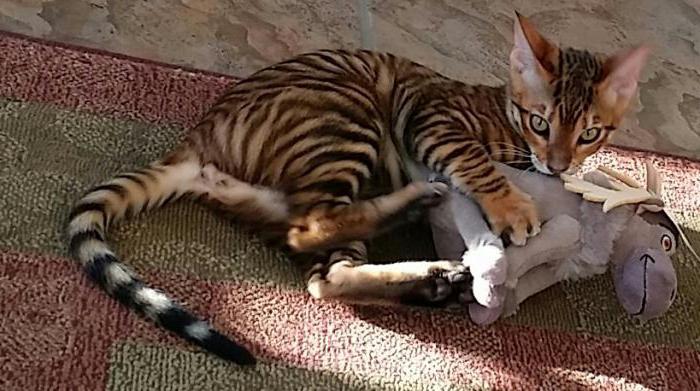
The toyger's head should be decorated with circular marks, which ordinary ones do not have.
Special requirements are put forward for the color of the fur. The background color should be brown, orange brown, or golden brown. Stripes are required to decorate not only the back, but also the stomach, chest, head, and even ears. A prerequisite is the absence of longitudinal stripes on the body of the animal. The toyger fur should feel like plush to the touch. Ideally sides muzzles are decorated with sideburns. The shape of the ears of this breed is rounded, the eyes are medium-sized. They are slightly covered by overhanging eyelids.
Despite the wild appearance, the toyger is a very playful pet. He is sociable and non-aggressive, while he is strongly attached not only to the house in which he lives, but also to the owners.
Marble cat
Pardofelis marmorata, or - a wild breed. This feline in appearance resembles a clouded leopard, although it is slightly larger in size than a domestic cat. According to genetic examinations, the direct relatives are the Kalimantan cat and the Asian golden cat. In 2002, it was listed in the Red Book as an endangered species.

Appearance description:
- The marble cat has a brown-gray color with a reddish tint. The wool is decorated with black stripes.
- The shape of the head is rounded, short. The forehead is wide.
- The cat has large brown eyes.
- The legs are short, while the paw is rather wide.
- The tail is very fluffy, of great length, sometimes it can exceed the size of the body and head.
Ocicat breed
Not all rare breeds of wild cats can boast of real predatory ancestors. For example, representatives of the Ocicat breed are insanely similar to wild ocelots. But they do not have the genes of these predators. The breed is bred entirely on the basis of pets. In a long list of progenitors, you can find the Siamese, Abyssinian, American Shorthair cat.

Ocicats have a light brownish-gray coat with elongated dark spots. The base of the tail, neck and head are decorated with rings and stripes.
bengal cat
This cat breed is amazingly beautiful. She resembles a small leopard not only appearance but also habits. The creation of this hybrid was painstakingly worked in America. The first attempt to cross a wild Bengal cat with an ordinary domestic "Murchik" occurred in 1961. American Jeanne Mill brought a wild kitten from a trip to Bangkok. Very beautiful offspring were born from him, but most of them died of leukemia. This happened in every litter. Around 1976, the University of California took up the issue of breeding a new breed. Here they managed to achieve the emergence of a viable breed of wild cats for home keeping.

The Bengal cat turned out to be a little larger than the usual domestic breeds. She is agile, strong and graceful. But essential quality for the owners - an extraordinary mind. The animal is considered the most intelligent cat breed. The Bengal cat has rounded paws and a smooth, medium-length tail. The muzzle of the cat is wide, and the large oval eyes are set wide apart. Eye color can be anything, but if you are offered a colored cat with blue eyes, then this is not a Bengal breed. Only the snow bengal has blue eyes. This is the name of the silver color, which is the rarest and most expensive in this domestic breed of wild cats. The ears of the animal are medium, but they are slightly tilted forward, which is also considered a sign of the breed.
The coat of the Bengal cat is dense and short. It shines like it was rubbed with a special tool. Regardless of the main color, clear spots or rosettes go through the coat, the color of which can be either brown or black.
Savannah
This is another hybrid obtained by crossing a predatory shrub with domestic breeds. Savannah was bred around 1986. The work was carried out by lovers of the breed of big wild cats, so the result is larger than ordinary pets. The first kittens were bred by Patrick Kelly and Joyce Sroufe. Breed standards are approved by the international association, but they are recognized only in 2001.

At the withers, the savannah can exceed 60 cm, and a unique pet weighs up to 15 kg. And in this case, we are not talking about overfed, beloved pets, but about active, lean animals. The body of these cats is elongated, the neck is elongated, and the paws are rather long. The ears are large and round, because of them the head seems somewhat small. The coat is short, pleasant to the touch and very thick. Colors can be quite varied. There are brown, chocolate, golden and silver savannahs. The coat of the representatives of the breed is covered with numerous spots.
Wild domestic cat (Savannah breed) - bright representative struggle of opposites. She is active and calm at the same time. The cat needs to move, she spends a lot of time on the street. But at the same time, dog-like devoted to the owner. And savannahs are not at all afraid of water.
Usher cat
In 2007, the wild breed of Ashera cats was introduced to specialists. She was positioned as a large hypoallergenic pet, bred on the genetic basis of African servals, Asian Bengal cats and domestic breeds. The price of a kitten reached 27 thousand dollars, an adult cat could be bought for 6 thousand dollars.
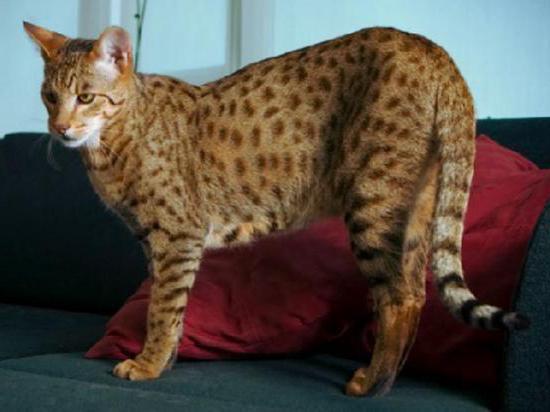
Later it turned out that the new breed was not so new. The enterprising swindler was just trying to cash in on his love for unusual pets. Breeder Chris Shirk suggested that the wild breed of cats, whose name is Ashera, does not exist, and the specimens presented are savannah cats from his cattery. To prove his assumption, the breeder demanded a DNA test. Official examination exposed the swindler.
Serval
Several hybrids have already been bred by crossing with other breeds. But it turns out that wild predatory servals can be kept at home in a pure, rather than a hybrid form. If a serval is taken into the house as a kitten, then it is well domesticated. But with such a pet you need to be careful. Although the animal becomes a devoted and affectionate pet, it does not lose the reflexes and habits of predatory ancestors. By the way, servals are excellent swimmers. They are not afraid of water at all.
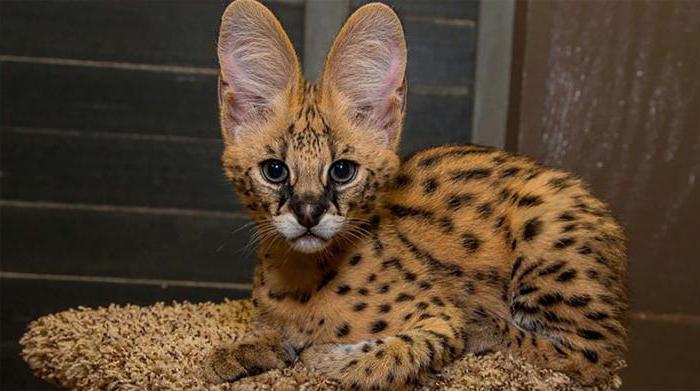
dune cat
We have described breeds of domestic cats similar to wild ones. But our story was about large animals. Now imagine an adult fluffy animal that looks like a kitten all its life. This dune is the smallest representative of wild cats. The body length of the baby along with the tail is about 80 cm. The maximum weight of an adult male is 3.5 kg, females are somewhat smaller.
Dune cats are well domesticated. They make pretty fluffy pets with curious wide muzzles. The head of the animal seems to be a little flattened, and beautiful sideburns grow on the sides. The ears of the dune cat are large, slightly pointed. The animal has excellent hearing.

pixie bob
Many breeds of wild cats look funny, not aggressive. These include a pixie-bob obtained by crossing domestic cats with a short-tailed forest cat. Outwardly, the pixie bob looks like a wild lynx. The breed is often confused with the Maine Coon and the domestic lynx, but there is a slight difference - a short tail and a special look. The eyes of cats are set deep, their shape is similar to a closed triangle.
Among the features of the breed are polydactyl paws. Animals with such a deviation are even allowed to show.
The pixie bob is very similar in character to a dog. This is a smart and loyal animal, amenable to training. He is attached to the host family and participates in her life, while not making any special demands on the content.

Bombay
Remember the beautiful panther from the Mowgli cartoon? Would you like to have one like this at home? Of course, a large predatory cat is not very suitable for home keeping, but a miniature bombay is just right! Mickey Harner worked on the creation of the breed for almost 20 years, but the result was worth it. The Bombay Mini Panther looks amazing. The animal has a blue-black shiny coat and bright orange eyes. The movements are smooth and graceful, like a real wild beast.
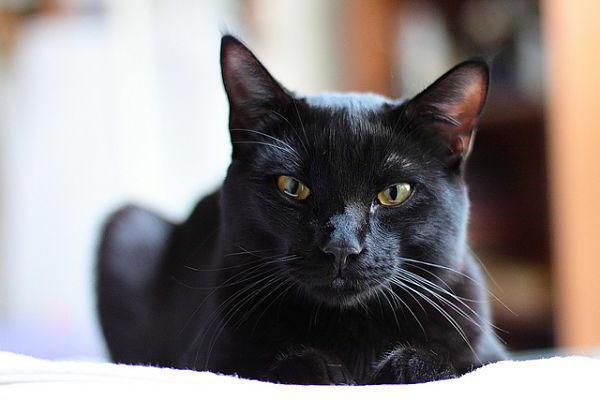
Shawzi cat
Breeds of wild cats can be very different. But oddly enough, they most often make sociable, unpretentious, devoted pets. The Shawzi breed, obtained by crossing reed cats with domestic cats, was no exception. The animal turned out to be large, tall and heavy. An adult cat can weigh more than 15 kg.
The breed is characterized by an elongated triangular head shape with a small muzzle. The ears are large, with a wide base and pointed ends. Tassels are often visible. By standard, the tips of the ears and tail should be black. Shawzi wool has a unique structure. She has a very dense undercoat, and each hair is decorated with two noticeable dark stripes. These stripes form a pattern on the legs and tail, and on the body it is almost invisible. Color can be black, gold, brown, silver. The chest and belly are always lighter than the back.
By nature, the breed is curious and energetic. Cats love to jump and master heights.
Every cat owner is sure that his pet is unique. But some breeds of animals are actually unusual. If you like the feeling that a tame predator lives in your house, then get a cat breed that looks like wild animals.
The cat family is very cautious, mysterious, graceful and unusually attractive animals. Unfortunately, many of them are already listed in nature protection books or are even on the verge of extinction, and hunting is prohibited. We decided to make Top 20 most beautiful representatives of the cat family living all over the world and occupying a wide variety of habitats. You can also check out the Rating of the most beautiful cat breeds.
In addition, on the site you can see a collection of photographs on the topic: Friendship of a man and a lion, Friendship of a man and a tiger.
20. Serval (bush cat)
Predatory mammal of the cat family. Servals are distributed almost throughout Africa, excluding the Sahara, foreststhe equatorial zone and the extreme south of the mainland (Cape Province). North of the Sahara (Algeria, Morocco) this beast is now extremelyrare, but still quite common in East and West Africa. There are about 14 subspecies. HThey inhabit open spaces with shrubs and grassy thickets, settling, as a rule, near water. They areavoid deserts, dry plains and tropical rainforests, keeping to the edges of the latter.It is an object of fishing, as its skin is used for fur products; it is also valued in parts of Africa due toyour meat. It is also exterminated due to attacks on poultry.
As a result, in the densely populated areas of Africa, the number of servals has dropped markedly. Quite easily tamed andcan be kept in captivity as pets. Serval males can mate with ordinary domestic cats, giving hybrids -"savannah".
19. Jaguarundi

A species of predatory mammals, which also includes the genus Puma. Outwardly, the jaguarundi somewhat resembles a member of the familymustelids or viverrids: she has an unusually elongated, flexiblea body on short strong legs and a long thin tail, which in general makes it look like a weasel or Madagascar fossa.Demonstrates great flexibility in the choice of habitats. These cats were found in the savannas, in the thorny thickets of chaparral, duringhumid tropical forests. Features of the structure of the body allow him to easily make his way among the thick grass and shrubs.Jaguarundis often settle near water - in wetlands, along the banks of streams, rivers and lakes. In the mountains they climb to a height of up to3200 m above sea level. Secretive animals leading a predominantly solitary lifestyle (with the exception of the mating season).Unlike most cats, jaguarundis are active mainly during the day; the peak of their activity falls on 11hours of the morning. Jaguarundis are terrestrial animals, however they can climb and swim well. Due to its wide range, this animal is notbelongs to the protected species, although in the southern United States it has become rare. Little is known about its abundance and ecology.

Wild cat of Southeast Asia: in the eastern Himalayas, Sumatra and Borneo. Marble cats are slightly larger than domestic cats. Their length is about 55 cm, not including the 50 cm tail. The coat pattern is reminiscent of a clouded leopard. Their immediate habitat is tropical forests. Being a nocturnal hunter, the marbled cat feeds on rodents, especially squirrels, toads, birds and insects. Unlike the Bengal cat living on the ground, it moves mainly in the branches of trees, and thus both species do not compete with each other. Hunting for it is prohibited in Bangladesh, China (only in Yunnan), India, Malaysia, Indonesia, Myanmar, Nepal and Thailand.

Wild small cat from the genus of Asian cats. A close relative of the Bengal cat. The smallest member of the cat family. Lives only in India and Sri Lanka. The species is threatened with extinction as the species has fewer than 10,000 adults.representatives with a constant decline, due to changes in the natural habitat.Ceylon rusty cats live in the rainforest, while the Indian population inhabits dry open areas.Rusty cats are nocturnal and live alone. Their behavior is very close to that of a Bengal cat. To theirprey include mice, lizards and insects. Despite being good at climbing trees, rusty cats most of the timeusually carried out on the ground.
16. Cheetah

A predatory mammal of the cat family, the fastest land animal. Noticeably different from other members of the cat family. The body is slenderwith well-developed muscles and practically no body fat, it even seems fragile. The claws are partially retractable, which is not typical for cats and except forthe cheetah is observed only in the fishing cat, Sumatran and Iriomote cats. Cheetahs are diurnal predators. They are huntingmainly on medium-sized ungulates: gazelles, impalas, wildebeest calves, as well as on hares. Three cheetahs can defeat an ostrich.87% of the cheetah's prey is Thomson's gazelle. Cheetahs usually hunt early in the morning.or in the evening, when it is no longer very hot, but still light enough. They navigate more by sight than by smell. Unlike other cats,cheetahs hunt by stalking prey, not by ambush. In pursuit of the victim, it develops speed up to 110-115 km / h, accelerates to 75 km / h in2 seconds. In Africa, the cheetah is the weakest of large predators. Hyenas, leopards and lions can take prey from cheetahs,taking advantage of the fact that the cheetah needs up to half an hour to rest after the chase. The cheetah only eats the animals it has killed.himself, sometimes drags prey into the bushes,to hide it from predators and eat it later, but more often it hunts again each time.

Margay is sometimes kept in South America as a domestic cat. Forest margays differ from ordinary pets in strong long legs in addition, they are somewhat larger. The length of a cat without a tail is about 60 centimeters. They are also called a smaller copy of the ocelot. But the margay's tail is special - two-thirds of the length of the entire cat, it is decorated with stripes and rings. Margay is also called the long-tailed cat. He balances with his tail, moving in crowns along thin branches. It lives in trees and finds its prey there. Just like an ordinary cat, margay hunts lizards or small birds. The only one of all felines, the margay can twist its ankles 180 degrees and climb a tree just like a squirrel - up or down. Due to deforestation and the diligence of hunters, margays are becoming rarer, and are already recognized as an endangered animal. Alas, in zoos they breed very poorly.
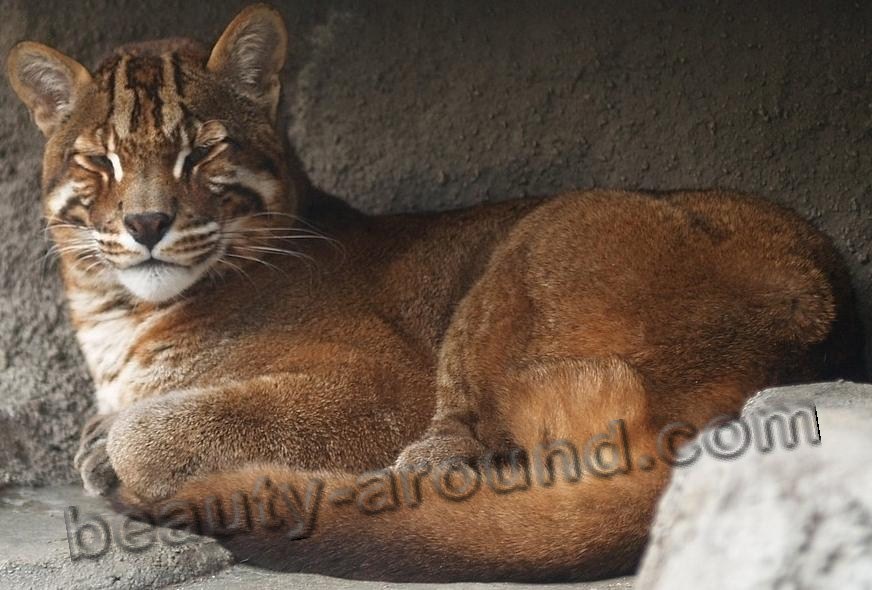
A wild cat of the genus Catopum, living in the tropical forests of the South East Asia. Previously, it was attributed to the now abolished genus of golden cats. Today it is believed that its resemblance to the golden cat found in Africa is based on convergent evolution. The species is named after the Dutch zoologist Konrad Temminck. More than twice the size of a normal domestic cat. Its length is 90 cm, not counting the tail, which is 50 cm long. The range of the Temminka cat stretches from the Himalayas and southern China to the Indochinese Peninsula, and it is also found in Sumatra. Inhabits forest biotopes. Due to deforestation and hunting, the Temminka cat has become a rare animal. In China, its meat is considered a delicacy, and its bones are used in traditional Chinese medicine. In Thailand, there are a lot of legends around her, according to one of which it is believed that burning the hair of the Temminka cat drives away tigers from the surroundings, and carrying at least one hair from her wool, according to local signs, protects against tiger attacks.
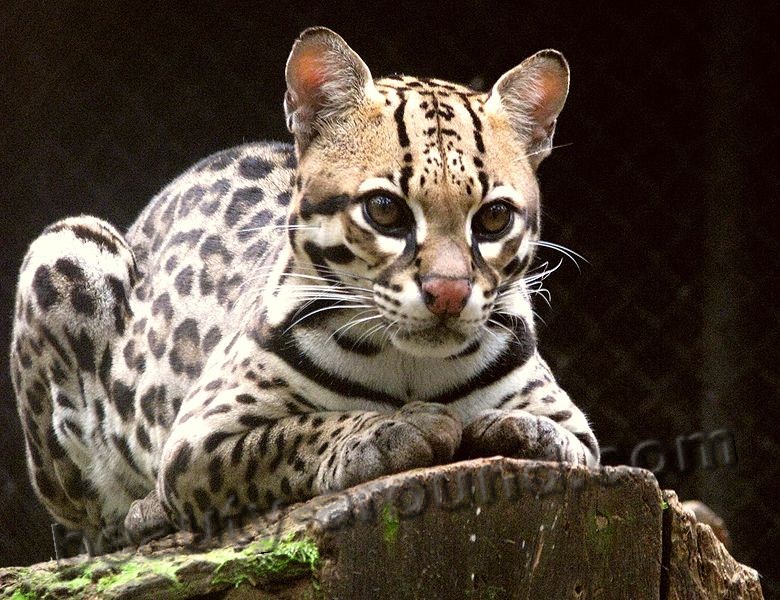
Predatory mammal from the cat family, common in Central America, northern and centralparts South America. Most northern region ocelot habitats - american state Texas. Its population is concentrated intropical forests, ocelot avoids open spaces. Ocelots live alone and hunt primarily at night. Duringduring the heat of the day, they like to hide in the hollows of trees. Despite their excellent ability to climb trees and stones, they huntearth. Ocelot prey includes mainly small mammals and birds, howeversometimes they do not disdain snakes. The largest specimens of the ocelot also overpower small donkeys and pigs.Due to the intense hunting for it, the ocelot has become an extremely rare animal in our time. Thanks to new interstateunder the agreements, the hunting of ocelots, as well as the sale of any products made from ocelots, is prohibited.
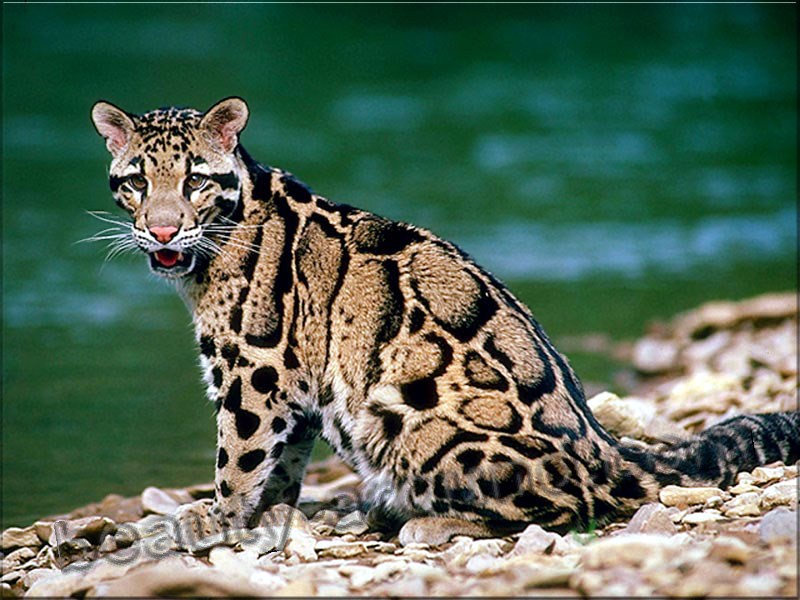
A member of the cat family that lives in Southeast Asia. It vaguely resembles a leopard and is considereda fairly ancient species, as well as a possible ancestor of the current large felines. Its value corresponds to approximatelyshepherd size. Clouded leopard is found in southeast Asia: from southern China to Malacca and from the eastern Himalayas toVietnam. The subspecies found in Taiwan is extinct. His biotopeare tropical and subtropical forests located at altitudes up to 2000 meters. Live alone and move around normallyin the thickets. The long tail helps them keep their balance in difficult environments. Among the feline smokyLeopards are the best at climbing trees. They also swim well. Their prey includesdeer, wild boars, monkeys, birds, goats, reptiles. They wait for their victims on the branches and suddenly jump on them from above.Because of the precious skin, the clouded leopard was hunted a lot in the past. Today it is threatened by poaching, butgreatest danger to its conservationrepresents the progressive deforestation of the tropical forests that are its home.
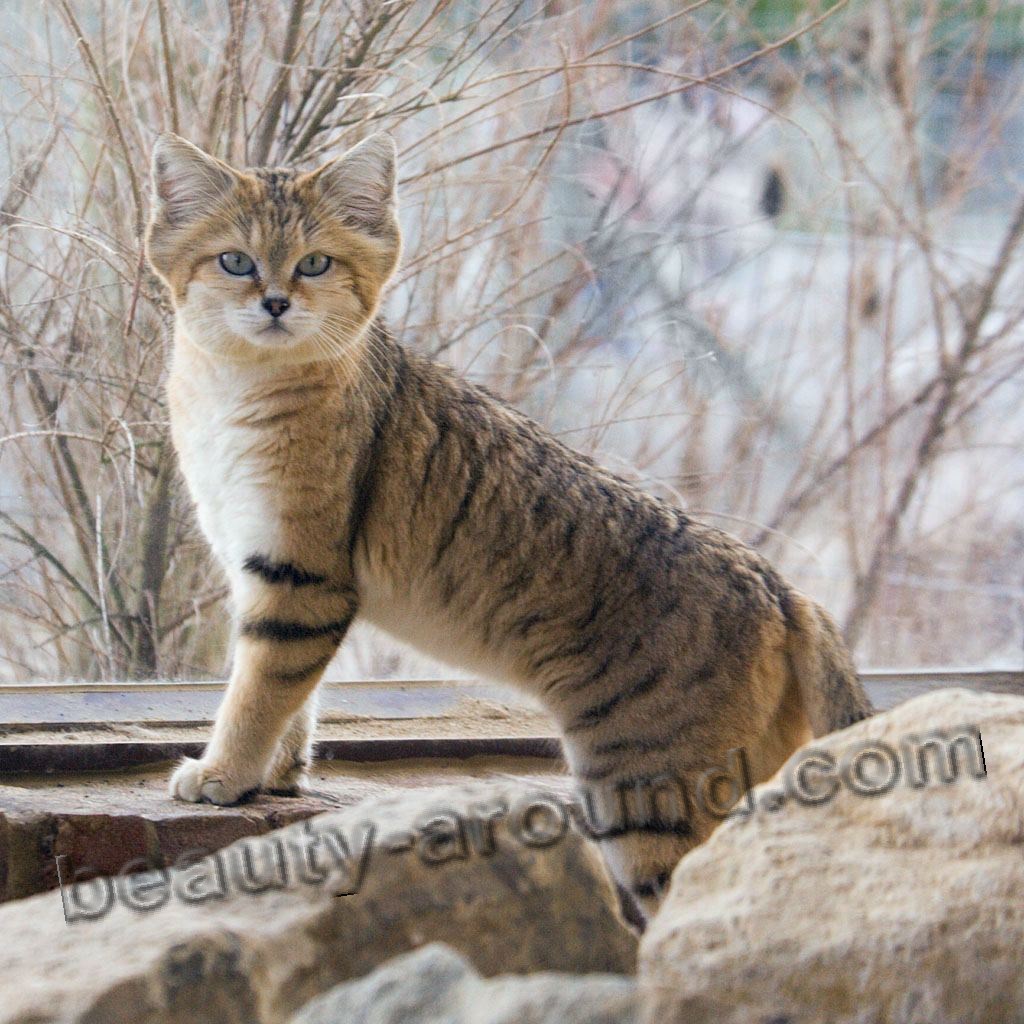
Type of cat family. The dune cat is the smallest among wild cats: its body length is 65-90 cm,with 40% occupied by the tail. The feet are covered with hard wool, which protects the soles of the paws from burns with hot sand.The fur is thick and soft, protecting the body from low night temperatures. The range of the dune cat looks like a strip startingin the Sahara (Algeria, Morocco, Chad, Niger) and through the Arabianpeninsula to Central Asia (Turkmenistan, Uzbekistan, Kazakhstan) and Pakistan. Lives exclusively in hot, dryareas. Its habitats are very diverse, from sandy deserts. Dune cats are strictly nocturnal.Only the Pakistani subspecies is active mainly at dusk in winter and early spring. From the heat of the day they are saved inshelters - in the old holes of foxes, corsacs, porcupines, as well as in the expanded minks of ground squirrels and gerbils.Cats are carnivorous; their diet includes almost all the game that they can find. Its basis is made up of gerbils,jerboas and other small rodents, lizards, spiders and insects. Sometimes tolai hares and birds whose nests are ruined.The dune cat is also known for its hunting of poisonous snakes (horned viper, etc.). In winter, she sometimes approaches the villages,but does not attack domestic cats and birds. Most dune cats get moisture from food and can for a long timego without water. The natural enemies of dune cats are snakes, large birds of prey and jackals.Sometimes they dig shallow holes or pits on their own, where they hide in case of danger. Ppractically devoid of vegetation, to rocky valleys overgrown with shrubs. They are not huntedhowever, they are caught for sale. They also suffer from the destruction of their natural habitat.In general, the dune cat is the most “prosperous” species among wild cats.

Predatory mammal of the cat family. His second name - Pallas cat - he received in honor of the German naturalistPeter Pallas, who discovered manul on the coast of the Caspian Sea in the 18th century. Manul is an animal the size of a domestic cat.The fur of the manul is the most fluffy and thick among the cats. Distributed in Central and Central Asia, from South Transcaucasia andwestern Iran to Transbaikalia, Mongolia and Northwestern China. Manul habitats are characterized by sharply continentalclimate with low temperatures in winter and low snow cover; it is most numerous in areas with little snow. Inhabitsmanul steppe and semi-desert areas. leads a sedentary lifestyle. Active mainly at dusk and early morning; sleeps during the dayin shelter. The slowest and most clumsy of wild cats. Manul feeds almost exclusively on pikas and mouse-likerodents, occasionally catches ground squirrels, tolai hares, marmots and birds. Manul is not adapted to fast running. At risk forit is characterized by hiding; he also escapes enemies by climbingon stones and rocks. An alarmed manul makes a hoarse rumbling or a sharp snort.Manul is rare or extremely rare, and its numbers continue to decline. In some places it is on the verge of extinction,listed in the Red Book Russian Federation, on the IUCN Red List as Near Threatened. manul huntinguniversally prohibited.
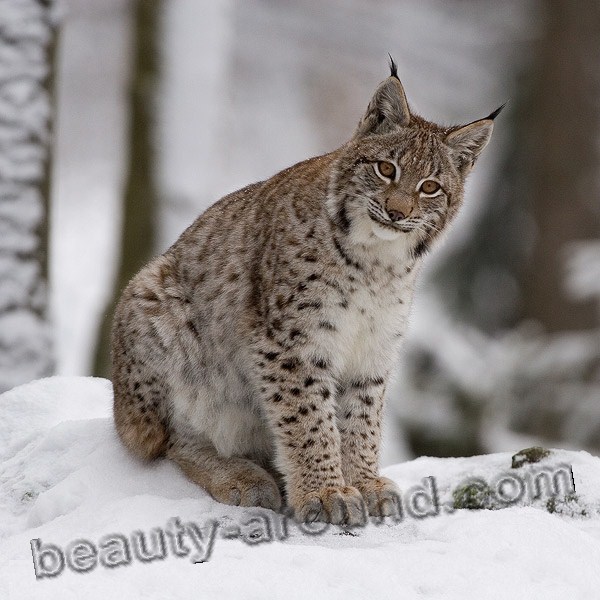
A species of mammals from the genus lynxes, the northernmost of the cat species; in Scandinavia, it is found even beyond the Arctic Circle.It was once very common throughout Europe, but by the middle of the 20th century it had been exterminated in most countries of Central Asia.and Western Europe. Successful attempts have now been made to revive the lynx population.forests, taiga, although it occurs in a variety of plantations, including mountain forests; sometimes enters the forest-steppe and forest-tundra.She climbs trees and rocks perfectly, swims well.She also survives well in the snow (beyond the Arctic Circle), catching fur-bearing animals. With an abundance of food, the lynx lives settled, withlack - roams. It can travel up to 30 kilometers per day. Hares form the basis of its diet. She alsoconstantly hunts grouse birds, small rodents, less often - small ungulates, such as roe deer, musk deer, spotted andreindeer, occasionally attacks domestic cats and dogs, in addition - foxes, raccoon dogs and other medium-sized animals.According to Russian zoologist Mikhail Krechmar, not a single confirmed case of a lynx attack on a person is known.Moreover, the lynx is known as one of the most easily tamed animals.
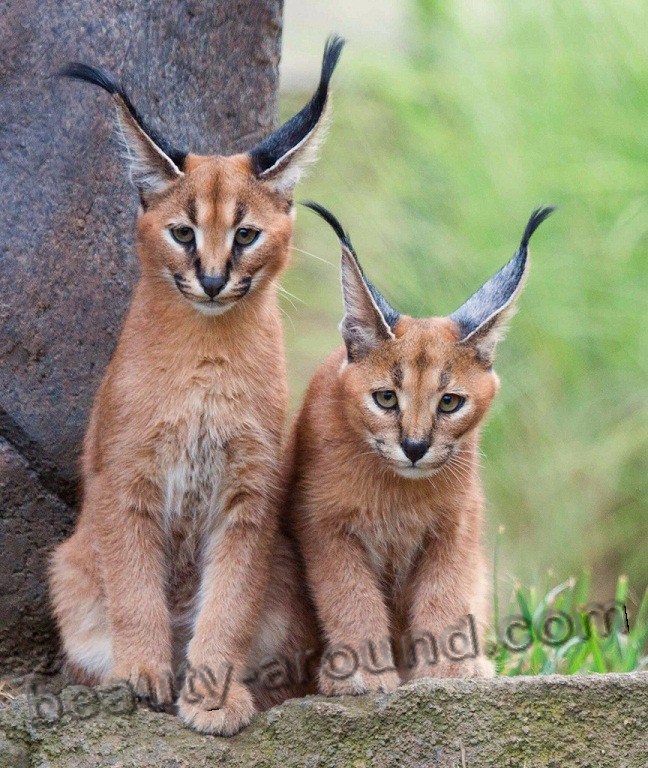
Predatory mammal of the cat family. For a long time, the caracal was attributed to lynxes, to which it looks similar, but a number ofgenetic features singled him out in separate genus. Despite this, the caracal stands closer to lynxes than other cats.Although outwardly the caracal looks like a lynx, morphologically it is closest to the puma. The caracal is also close to the Africanserval, with which it crosses well in captivity. Found in the savannas, deserts and foothills of Africa, in the deserts of the Arabianpeninsulas, Asia Minor and Central Asia. Not numerous in the CIS: found in the deserts of southern Turkmenistan, along the coastThe Caspian Sea reaches the Mangyshlak Peninsula, in the east it sometimes appears in the Bukhara region of Uzbekistan.The caracal is active mainly at night, but in winter and spring it also appears during the day. Sheltered in rock crevices andburrows of porcupines and foxes; sometimes they are used for several years in a row. Its main food is rodents (gerbils,jerboas, ground squirrels), tolai hares, partly small antelopes, in Turkmenistan - gazelles. Sometimes it gets hedgehogs, porcupines,reptiles, insects, small predatory animals like foxes andmongoose, young ostriches. It can steal poultry, attack lambs and goats. Caracals are easily tamed. In Asia(India, Persia) with hand caracals hunted hares, pheasants, peacocks and small antelopes. In Africa, especially Southcaracal is quite common and is considered a pest. There is a special culture of caracal hunting: it is lured by instruments,imitating the cry of a wounded hare or mouse, and at night they shoot from under the headlights. Besides, in South Africa caracals are usedto drive away birds (mainly guinea fowl) from the runways of military airfields.Asian subspecies of caracal are much rarer.
7. Leo

A species of carnivorous mammals, one of four representatives of the panther genus, belonging to the subfamily of big catswithin the cat family. It is the second largest living cat after the tiger -the weight of some males can reach 250 kg. The historical range of the lion was much wider than the modern one - even in the earlyin the Middle Ages, the lion was found throughout Africa, except for deserts and rainforests, and it could also be seenin the Middle East, Iran and even in a number of places southern Europe(for example, he lived in part of the territory of the modern south of Russia,rising to about the 45th parallel north). In North and Northwest India, the lion was a common predator. Howeverhuman persecution and habitat destruction have led to the fact that in Africa the lion survived only south ofSahara, its range is currently broken. In Asia, a small population exists in the Gir forest (in the Indian stateGujarat). Lions are considered vulnerable species due to the irreversible decline in their population. For the last twodecades, the number of lions in Africa has decreased by 30-50%. Populations are vulnerable outside protected areas.The reason for the decline is not fully understood, but the biggest threats are habitat loss and conflict. with a person.
6. Black Panther
![]()
The name of dark-colored individuals of a number of species of large cats, which are a genetic color variant - a manifestationmelanism caused by a gene mutation and is characteristic almost exclusively of females. An example of a strong spread of mutation,which leads to melanism, in the feline population, is the populationleopard in Malaysia, where about 50% of the animals are black in color.Black Panther is not independent view. Most often it is a leopard or a jaguar. The existence of melanistic cougarsnot confirmed. The word "panther" is often applied not only to individuals with a black color, but also to others with a normal color.(reddish or spotted), even white - the so-called "white panthers".
5. Jaguar
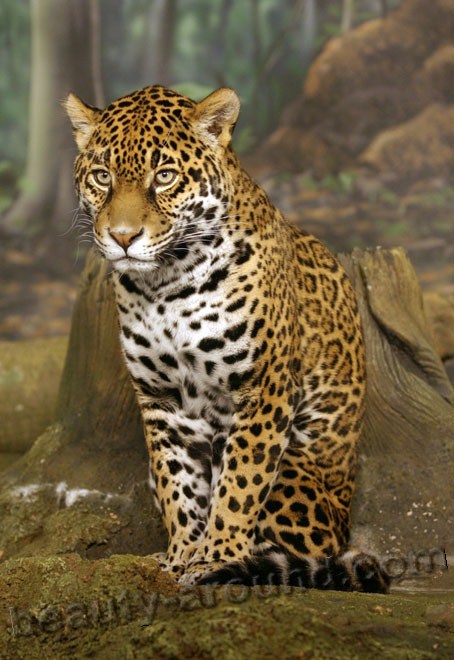
Big cats. The only representative of the genus in North and South America. The third largest in the world, and the mostlargest representative of the cat family in the New World. The range of the species extends from Mexico south to Paraguay and northArgentina. The main habitats of the jaguar are tropical rainforests and grasslands. The lifestyle of jaguars is solitary.The jaguar is a crepuscular predator. His most active hunting hours are after sunset and beforedawn. Its main prey is capybaras and ungulates like mazama deer, peccaries and tapirs, but it also attacks birds,monkeys, foxes, snakes, rodents. The jaguar also hunts turtles - its powerful jaws are able to bite through their shell. Unlikefrom the cougar, the jaguar willingly and often attacks livestock. The predator is an excellent swimmer and rarely misses the prey that is looking forrescue in the water. He also digs out of the sand on the ocean coastturtle eggs, sometimes throwing themselves at sleeping alligators or snatching fish from the water. Over much of its former rangethis species is almost or completely exterminated. The change by people of the natural habitats of jaguars, fishingfor the sake of a valuable skin, as well as shooting by cattle breeders who feared for the safety of their herds.The jaguar is listed in the international Red Book and is protected in many countries. Shooting jaguars in limited quantitiesallowed in Brazil, Mexico and some other countries. Hunting for trophies is allowed in Bolivia.
4. Leopard

In the XX century, it was included in the IUCN Red Book, in the Red Book of Russia, as well as in the security documents of other countries. However, in many African countries, the relatively high number of leopards makes it possible to allocate an annual quota for their prey. The big cat, however, is much smaller than the tiger and lion. The range of the leopard is wider than the range of any other member of the cat family, with the exception of the domestic cat. The plasticity of the species is explained by the secretive way of life and its ability to hunt a wide variety of animals. By the middle of the 20th century, the range of the leopard in the Caucasus was catastrophically reduced, its numbers are negligible, and in fact this subspecies is on the verge of complete extinction. Inhabits forest, partially forest-steppe regions, savannahs and mountainous regions of Africa and the southern Front and southern half of East Asia. The leopard feeds mainly on ungulates: antelopes, deer, roe deer and others, and during the period of starvation - rodents, monkeys, birds, reptiles. Sometimes attacks domestic animals (sheep, horses). Like a tiger often kidnaps dogs; foxes and wolves suffer from it. It does not disdain carrion and steals prey from other predators, including other leopards. The number of leopards throughout the range is steadily declining. The main threat to it is associated with changes in natural habitats and a reduction in food supply. The main concern is the poaching of animals for the needs of oriental medicine.
3. Puma (mountain lion, cougar)
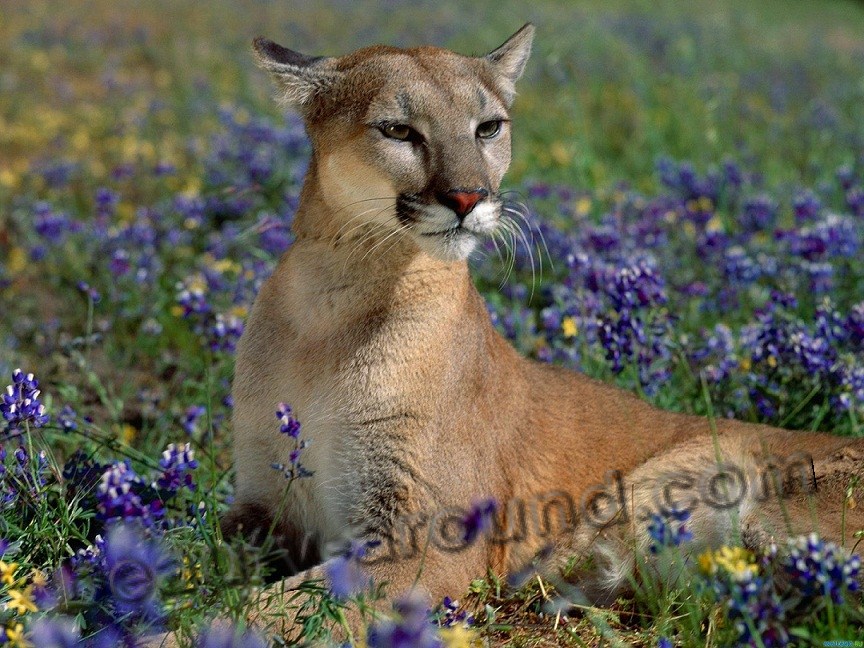
Type of cat family. The word puma comes from the Quechua language. The closest relatives of the cougar are the jaguarundi and the extinct North American genus Miracinonyx. The cougar is the second largest feline in America; only the jaguar is bigger than her. Historically, the range of the cougar was the most extensive among all land mammals in America. Even now, in terms of the breadth of distribution, the cougar is comparable (of the cats) only with the red lynx, forest cat and leopard. Initially, cougars were found almost everywhere from southern Patagonia to southeast Alaska; the area of its distribution quite accurately coincided with the area of \u200b\u200bits main prey - various deer. Now in the United States and Canada, the cougar has survived mainly in the mountainous western regions. in the east North America the cougar was completely exterminated; the exception is a tiny population of the Puma concolor coryi subspecies in Florida. Cougars lead a strictly solitary lifestyle. Puma hunts mainly at night. Its diet consists mainly of ungulates: black-tailed, white-tailed, pampas deer, wapiti (American red deer), elk, caribou, bighorns and livestock. However, the cougar can eat a wide variety of animals - from mice, squirrels, opossums, rabbits, muskrats, porcupines, Canadian beavers, raccoons, skunks, armadillos to coyotes, bobcats and other cougars. They also eat birds, fish, and even snails and insects. Unlike tigers and leopards, the cougar does not distinguish between wild and domestic animals, attacking livestock, dogs, cats and birds when the opportunity arises. In doing so, she slaughters more animals than she can eat. Despite the fact that cougars serve as an object of hunting and their range is declining due to destruction environment, most subspecies are quite numerous, since cougars easily adapt to life in different landscapes. It is also interesting to note that now some people have begun to tame cougars as their pets.
2. Snow leopard (irbis or snow leopard)

A large predatory mammal from the cat family that lives in the mountain ranges of Central Asia.Weighs up to 55 kg. Due to the inaccessibility of the habitat and the low density of the species, manyaspects of its biology. At present, the number of snow leopards is catastrophically small; in the 20th century, it was included in the Red BookIUCN, in the Red Book of Russia, as well as in the security documents of other countries. As of 2012, snow leopard hunting is prohibited.The range of the snow leopard in central and southern Asia covers the territory of mountainous regions with an area of approximately 1,230,000 km² andextends through the territory of the following countries: Afghanistan, Myanmar, Bhutan, China, India,Kazakhstan, Kyrgyzstan, Mongolia, Nepal, Pakistan, Russia, Tajikistan and Uzbekistan.Irbis is typical representative fauna of the high rocky mountains of Central and Central Asia. Among the large catsthe irbis is the only permanent inhabitant of the highlands. It mainly inhabits alpine meadows, treelesscliffs, rocky areas, rocky outcrops, precipitous gorges and is often found in the snow zone. Active at dusk, but sometimes during the day.The snow leopard is able to cope with prey three times its mass.The main prey of the snow leopard almost everywhere and all year round is ungulates. It should be noted that due to the constanthuman persecution, the number of snow leopards is continuously declining.
1. Tiger


A species of carnivorous mammals of the cat family, one of the four representatives of the panther genus, which belongs to the subfamilybig cats. Among the representatives of this species are the largest animals of the cat family. The tiger is one ofthe largest land predators, yielding in mass only to the white and brown bear. Nine subspecies of the tiger have been identified.In the 20th century, it was included in the IUCN Red Book, in the Red Book of Russia, as well as in the security documents of other countries.As of 2012, tiger hunting is banned worldwide. The tiger is an exclusively Asian species. Historical range of the tiger(now strongly dissected into separate populations, sometimes very distant from one another) is located on the territory of the FarEastern Russia, Iran, Afghanistan, China, India and the countries of Southeast Asia, including the Sunda Archipelago(Indonesian islands). In the wild, tigers mainly feed on ungulates, sometimes they can hunt domestic animals,such as dogs, cows, horses and donkeys. Throughout its range, the tiger is at the top of the food pyramid and almostdoes not experience competition from other predators.
All domestic cats have instincts and habits inherent in their untamed counterparts. It cannot be otherwise, because they have one ancestor - a wild cat. Now many of them are on the verge of extinction and are listed in the Red Book. The most famous breeds of wild cats are presented in this article.
It lives at an altitude of 3500m to 5000m in the mountains of Peru, Bolivia, Argentina and Chile, beyond the forest line. Severe survival conditions - melting snow as the only source of water and rodents - as a source of food - require human efforts to preserve this breed. The breed is poorly studied and very small in number. There are no more than 2.5 thousand individuals.
Dimensions are small: body length 57-64cm, tail 35-48cm, height at the withers 36cm. The coat is very thick, long and fluffy. Reaches 4 cm.
The tail is especially prominent. Firstly, it makes up 70% of the body, and secondly, it is very fluffy, which allows it to be used instead of a blanket in cold times.
The color of the fur is gray-silver with ashy specks on the back. The tummy and chest are lighter. All over the body there are diagonal spots, black on the legs, brown on the body, orange on the back. The soles are brownish grey. The color of the tail is usually lighter than that of the body. The decoration is 9 dark brown rings. The tip is black. Ears are grey.
dune or desert
![]()
Area - North Africa, Arabia, Iran, South Morocco and Central Asia. As the name implies, these cats live in the desert. Ideally adapted to difficult conditions, they have no big size: the body is from 65 cm to 90 cm, and up to 40% is occupied by the tail. The head is short, broad, flattened, with whiskers. They are nocturnal animals that hunt by ear. Therefore, they have very large and wide hearing organs. They don't have tassels. The eyes are yellow, very sharp, with a slit-like pupil.
The paws are large and strong. In search of prey, these desert dwellers travel up to 8 square meters. km per night. On the paw pads there is a dense coat that saves the hostess from burns on hot sand. The color of the Central Asian species is somewhat different from the African. In summer it is yellowish, and by winter it changes to gray. The coat thickens and lengthens so that the animal is warm in winter frosts.
On the body there are inconspicuous stripes of a gray-brown color. A more contrasting pattern of stripes is on the head and legs. And the tip of the tail is usually dark, down to black. The underside of the body is lighter than the top.
The main food is birds, rodents, non-venomous snakes. The main method of hunting is an ambush attack: the victim is grabbed by the neck and shaken vigorously. A feature of this type of cat is the ability to do without water for a long time: they get the necessary moisture from food.
Golden
There are two types: African and Asian.
African

lives in the tropics of Africa, in the rain forests.
She is twice as big as a normal cat. Size -72-94cm, average weight 11-14kg. Powerful legs, hind legs are longer than the front ones. The color is very diverse: red, chestnut, gray-brown, bluish-gray, even black. The inner surface of the legs, tummy, chest, chin and cheeks are white, the bottom of the tail is slightly colored. There are two stripes of dark color on the cheeks. Blackish speckles are present on the abdomen.
On the inside of the paws are wide transverse stripes. The eyes are outlined with a light border. The head is small. The organs of hearing are rounded, dark on the outside.
Like many felines, the golden is nocturnal. Excellent hearing, sharp eyesight, excellent flair allows her to hunt antelopes, goats and even buffaloes.
Asian
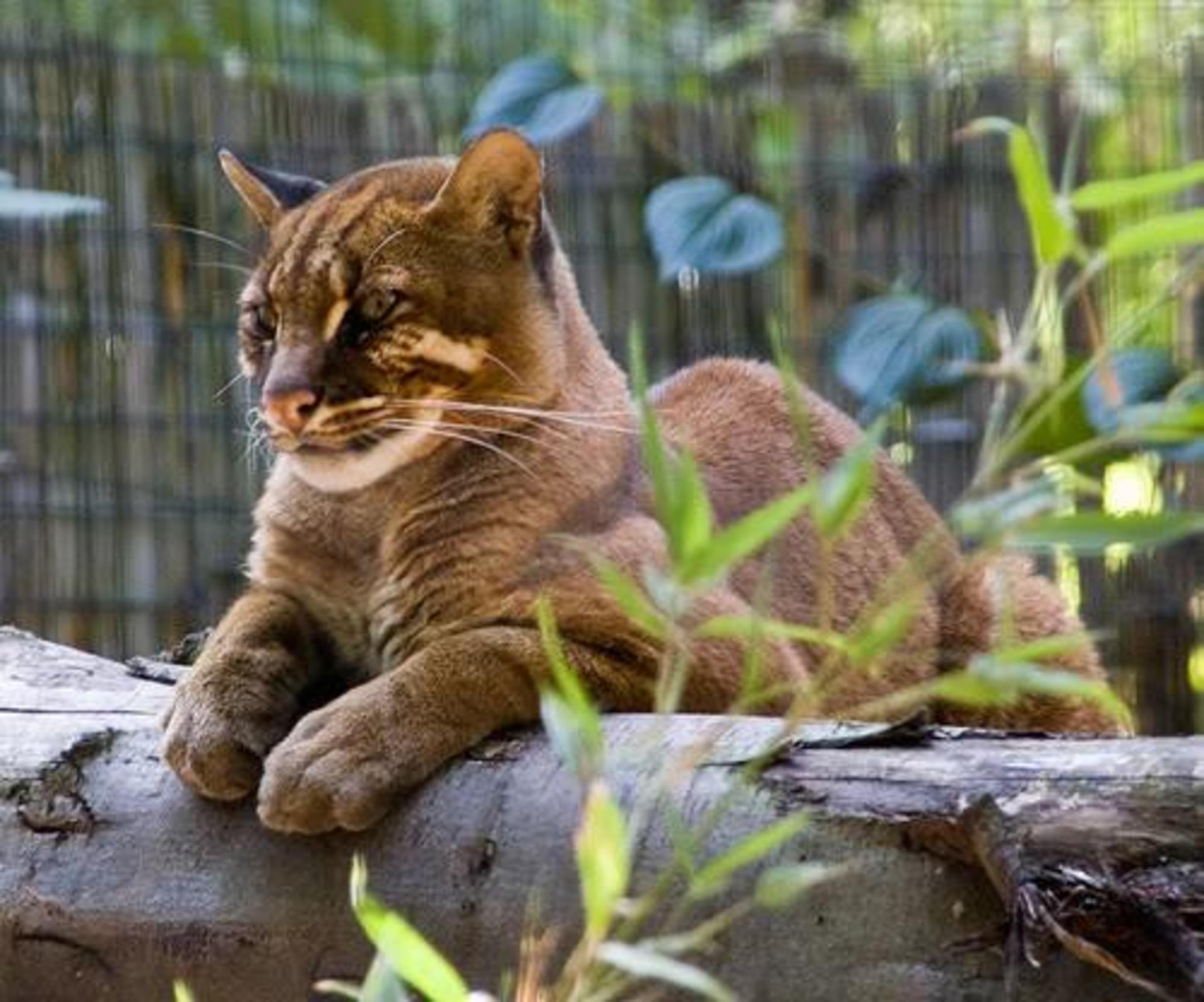
Another name is the wild cat Temminka. Lives in the jungles of Southeast Asia. Asian ones are slightly larger than African ones. Dimensions 75-105cm, weight 8-11kg. Although there are instances of 11-16kg.
The color of the fur is juicy golden, sometimes reddish. On the belly and flanks, the coat brightens to white. There are individuals of gray color.
The color can be monophonic, or it can be speckled with a light brown color. Behind the ears are visible clear gray speckles.
The Asian hunts during the day for hares, lambs, goats, small deer and birds. They are excellent at climbing trees. But the time of pregnancy and childbirth arrange hollows in them.
Angler or speckled (fish)
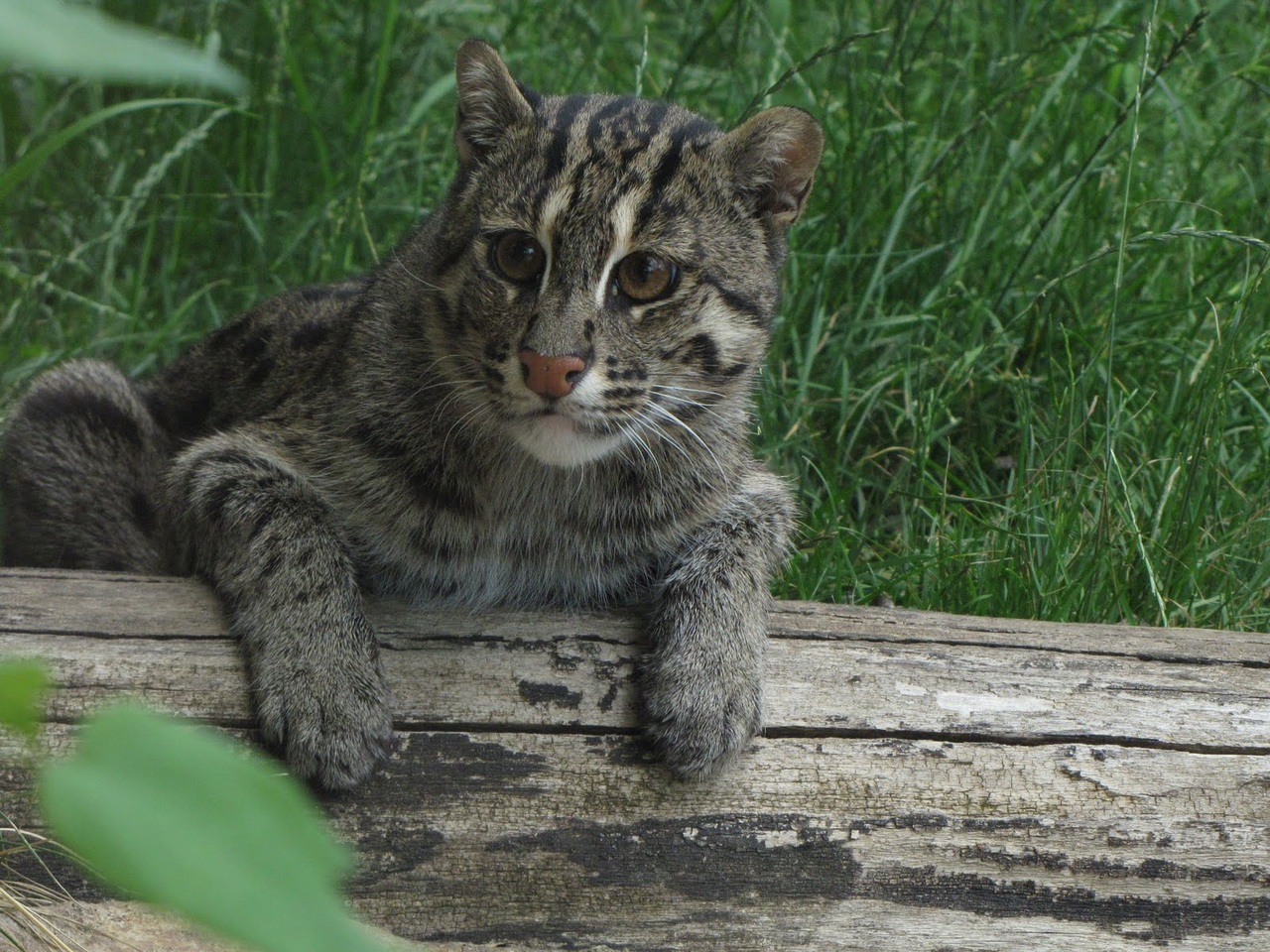
By name it is clear that they live near the water, eating caught fish. Although, frogs with lizards, even small mammals, can become prey. The range of anglers is Southeast Asia: small areas of China, India, Thailand, Vietnam, Sumatra.
The weight of an adult cat is 11-15 kg, females are twice as light - 6-7 kg. The size of the animal is 96.5-119.3 cm, the height at the withers is 38.1-40.6 cm. They are tough, strong animals. The muzzle is short and wide, practically without a bridge of the nose. The neck is short. The organs of hearing are located on the sides, small and rounded. The jaw is round, the lower one is more developed, very strong. The limbs and tail are short. It is thick at the base, tapering towards the tip. Anglers are able to use it as a steering wheel to change direction while swimming and balancing on the water.
The color of the fur coat is brownish-grayish with black specks on the body. The forehead and nape are decorated with longitudinal stripes. There are several dark rings on the tail.
Golden yellow eyes. The ears are black with white specks behind them. In case of aggression, when the angler presses them, they emphasize the angry expression on the muzzle.
A unique feature of anglers is the presence of webbing between the toes of the front paws. On the one hand, they interfere with retracting the claws, but on the other hand, they are indispensable when catching fish. The fisherman sits on the shore and carefully watches the water. As soon as the victim, i.e., the fish, enters the field of view, a lightning strike with a paw follows. If necessary, these hunters are able to dive deep in pursuit of prey.
Chinese (Gobi)

The range is the mountainous and steppe regions of the north-west of China, the south of Mongolia. These are areas with harsh climatic conditions: intense heat in summer and severe frosts in winter. Dry or damp winds blow throughout the year.
Compared to domestic ones, Chinese ones are slightly larger. The size is 97.7 cm, and a third of it is occupied by the tail - from 29 cm to 35 cm. Height at the shoulders 30-35 cm. Weigh from 4.5kg to 5.9kg. In appearance, they resemble European and at the same time look like a reed cat.
The head of the Chinese is wide, the ears are large, with tassels up to 2.5 cm. The fur is long and dense, with a thick undercoat. On the paw pads there are "sandals" - a layer of wool. The tail is thick, with transverse rings at the bottom.
The coat is yellow-gray in summer, becoming darker in winter, acquiring a brownish tint. Winter fur is thicker and longer than summer fur.
Dots and stripes are poorly visible, they are better seen on the sides. tummy in summer time almost white, yellowish in winter. The tail is blackish at the tip.
The main food is small mammals and rodents: rats, rabbits. Does not shun hunting for birds, such as pheasants.
Irimoto - Japanese wild cat
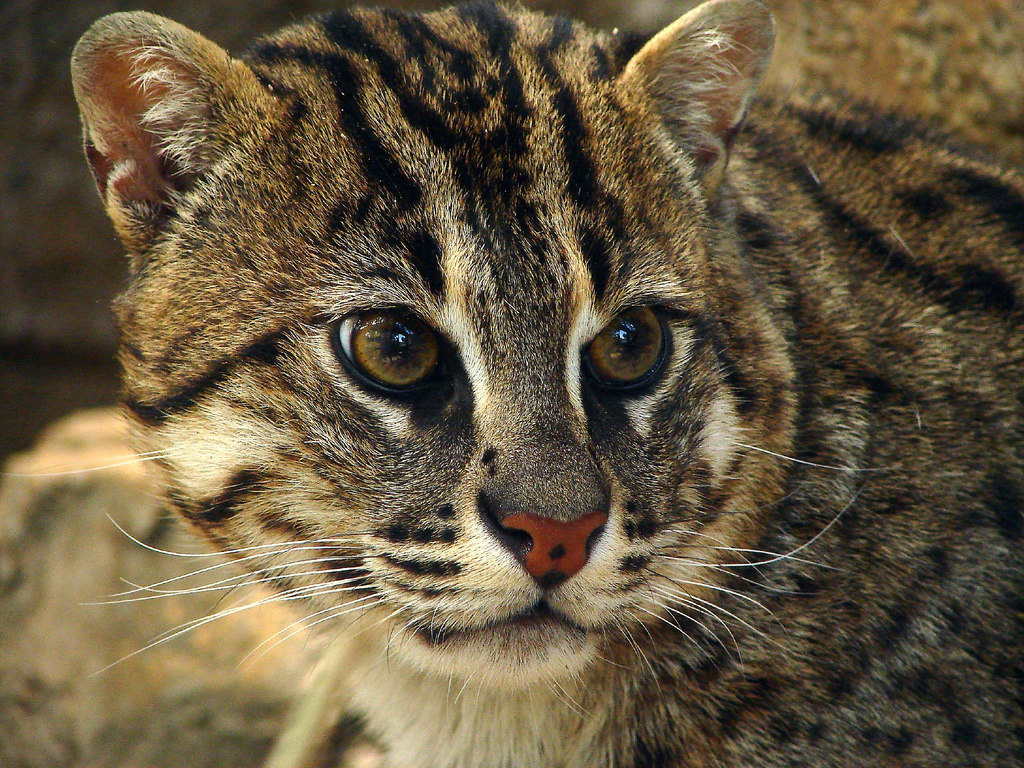
Lives on the island of Irimoto (Japan), part of the territory of which has been turned into national park. Everything is done there to make these rare wild cats feel comfortable and safe. For the life of the irimoto, they choose the rainforests of the subtropics, coasts with mangrove trees.
The size of the irimoto is from 70 cm to 90 cm, of which approximately 18 cm is a thick tail. Height - 25cm. These are small animals. They weigh 3-7 kg, on average 4.5 kg. The paws of the irimoto are low, the claws do not retract completely, there are membranes between the fingers. The coloring of the fur is dark brown with darkish specks of small size over the entire surface. The tail is also with darkish spots on the fluffy coat. The organs of hearing are dark with a white spot, rounded.
Confirmation ancient origin of this breed is the absence of one premolar tooth on the upper jaw. Therefore, irimoto, like a cheetah, has only 28 teeth.
And, like a cheetah, they have clear black stripes along the wings of the nose, coming from the corners of the eyes.
Irimoto's menu is very varied. Lots of rodents, fish, water birds, crabs, insects. Excellent hunters, these nocturnal predators freely enter the water, swim excellently, and easily climb branches.
Manul or pallas cat
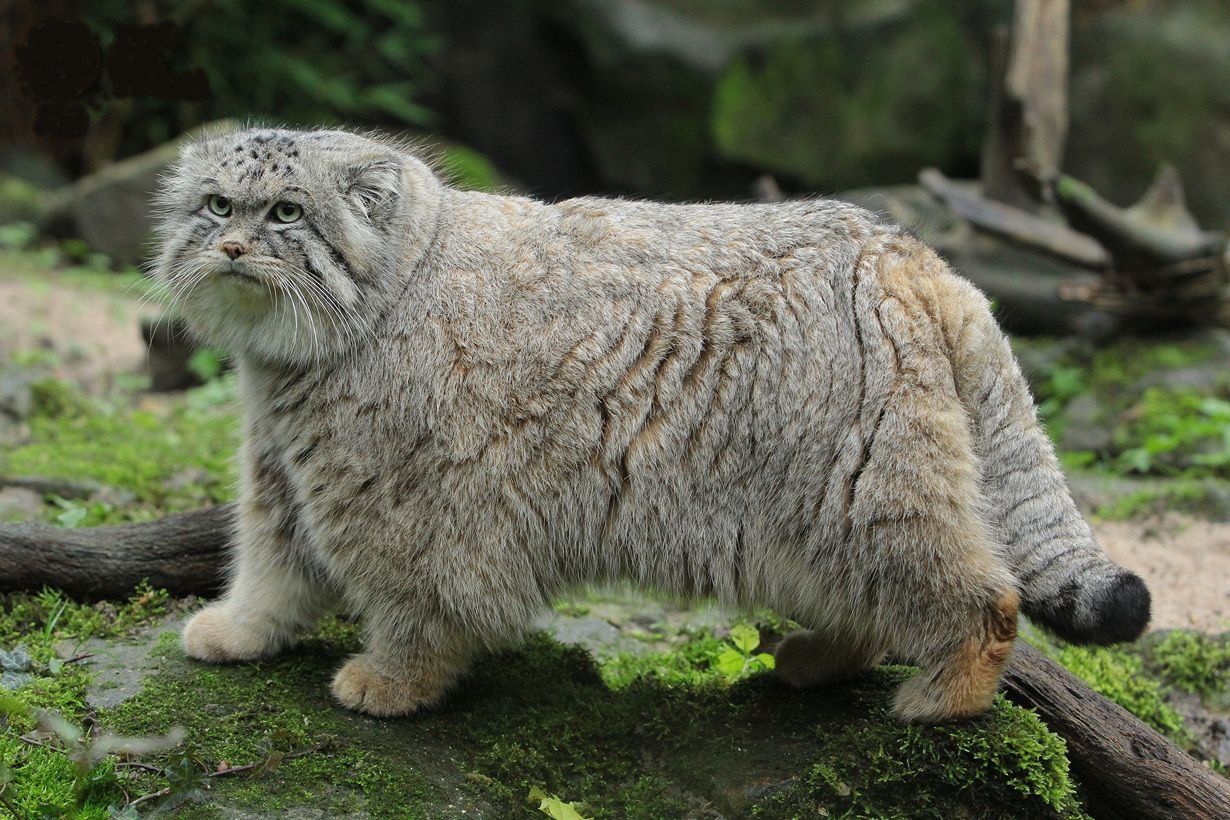
First discovered on the coast of the Caspian Sea in the 18th century. Lives in the steppe and semi-desert regions of the mountains. Very similar to the Persian cat, only larger. Dimensions 70-96cm, weigh 3.0-4.5kg. The constitution is dense, the limbs are low, stable. The head is wide, small in size. The organs of hearing are small, round, located on the sides. But the eyes are very large, yellow color. The pupils are round, as opposed to the vertical pupils of most felines. This wild cat is the record holder for fluffiness: manul has up to 9000 hairs in 1 sq. cm. Their length is up to 7 cm. And in the winter cold, the manul also acquires a chic undercoat.
The color of the coat is gray-reddish with small white specks. On the muzzle there are two blackish stripes: from the ears to the eyes.
Because of the low legs, the manul is not adapted for running. Therefore, it hunts, waiting for the victim in ambush: it sits near the holes. At the same time, he knows how to perfectly disguise himself, he hears and sees wonderfully. The sense of smell is less developed. The main food is pikas and mouse-like rodents, occasionally gophers, birds. This is a very silent and cautious creature: even during mating games, manuls do not emit loud cries, like most felines.
European wild cat

Lives in Western Europe, Asia Minor, the Caucasus, Moldova, southern Ukraine. It prefers forests (hence its second name is forest), thickets of shrubs and reeds at a distance from humans. Although, sometimes settles in the attics of houses.
The European cat has such an unremarkable appearance that a non-specialist can easily confuse it with an ordinary mongrel street purr. Forest from 50 to 90 cm in length, half of which is the tail, fluffy and powerful, chopped off at the end. Males weigh 7-8 kg, females are lighter. The limbs are low, the body is elongated, the head is large, the hearing organs are without tassels. The eyes are large and expressive.
Wool coloring - different shades gray with yellow. There are dark specks and transverse stripes on the body.
They hunt in the evening and at night with a short break in the middle of the night. These are very dexterous hunters, they easily climb branches, jump from branch to branch, and even swim perfectly in water bodies.
Jungle cat or swamp lynx, or -house
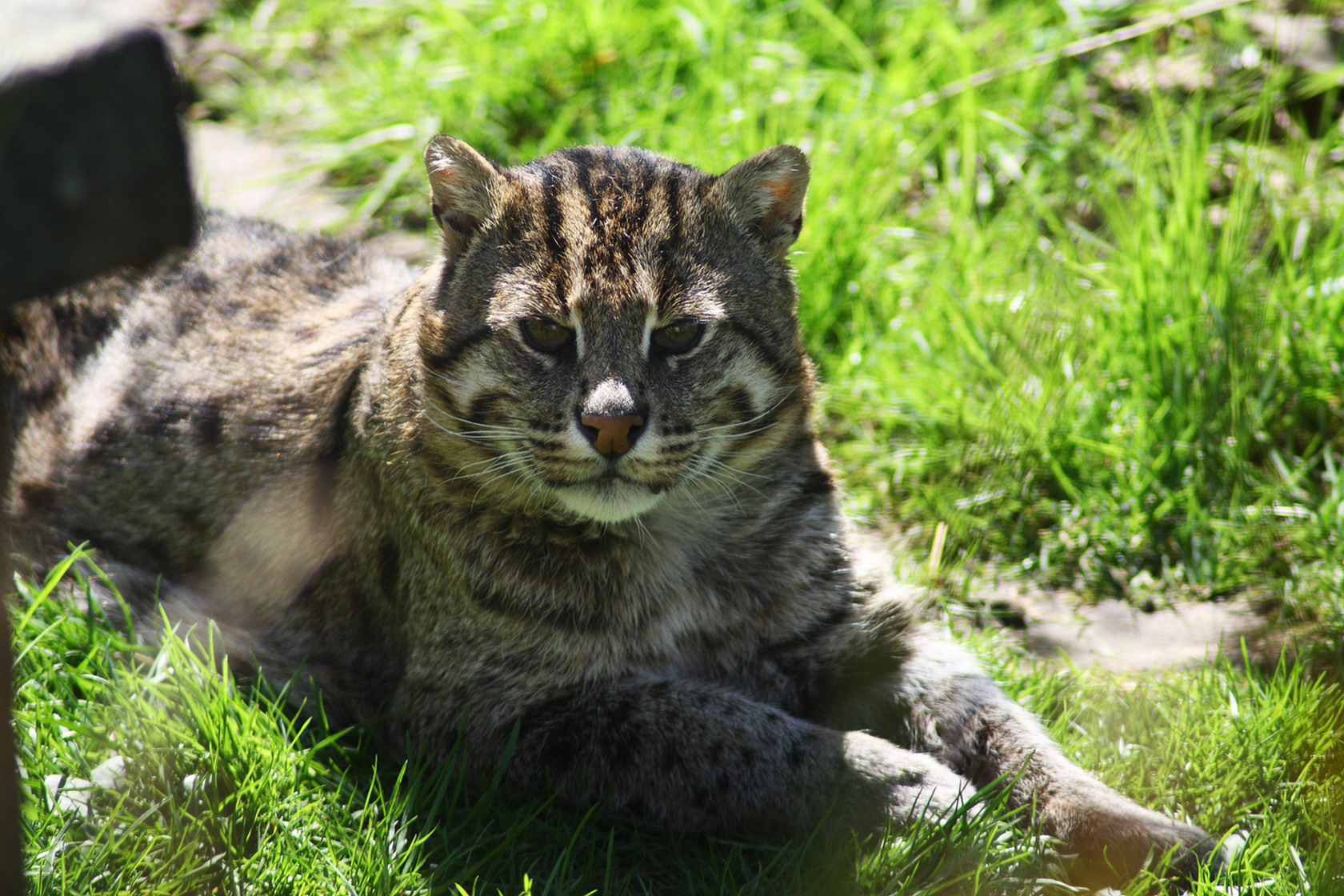
The range is very large: Asia, Transcaucasia, Dagestan, North Africa, Thailand. Prefers thickets, avoiding open areas. This largest wild cat looks like a domestic cat. Length 75 - 125cm. A third falls on a thin and pointed tail, decorated with blackish rings. Hausa weighs up to 15kg. The limbs of animals are very long. Growth ranges from short, like domestic cats in Thailand, to high - in the Caucasus and Palestine. There are nine varieties of swamp lynx.
Northern, living near the Aral, are dressed in a thick fur coat. Asian - have a bright reddish brown coat. African - painted in desert gray tones.
Hunts for rodents, hares, pheasants, cubs of artiodactyls. When hunting for waterfowl and small mammals that live near water, the Hausa are very helpful with their long legs. They do not allow the wool on the tummy to get wet. In addition, these predators swim remarkably, so fish is also included in their diet.
Longtail, or margay
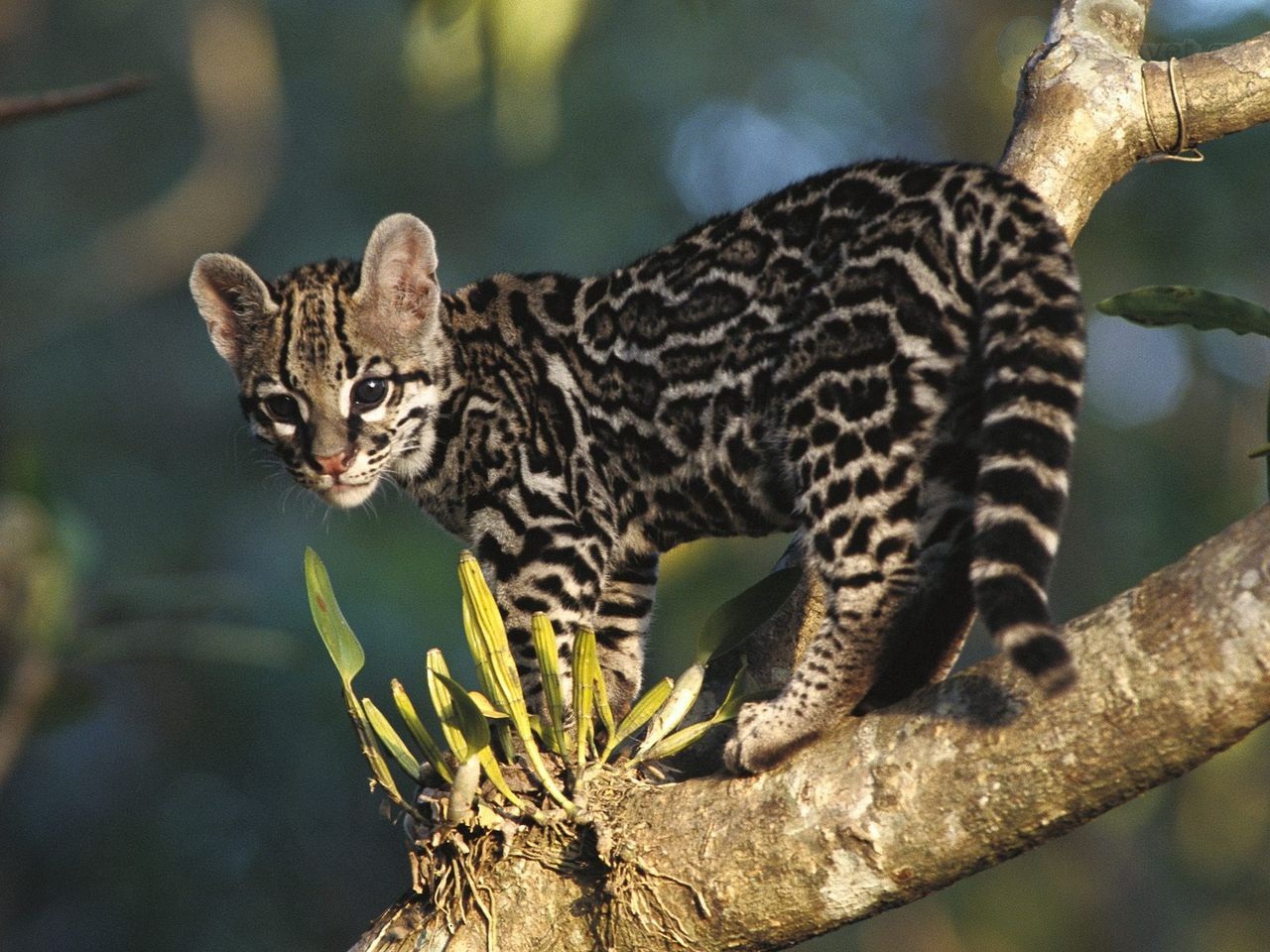
Habitat: north of South America - to Mexico. Found in Texas. Margal is a tree cat. The long-tailed is called so because it has a long tail, which allows the margay to balance when climbing thin branches.
The length of the margay is 90-120 cm, almost half of which is the tail. Weighs 2.5 - 4kg. Limbs are long. Unique Ability margay - they can turn their hind legs by 180. Being ideal climbers, margals can hang on branches, clinging to it with one paw. The auditory organs are rounded, darkish on the outside and with a white spot in the middle. The eyes are large, like those of all nocturnal animals. Color - dark brown. The pupils are oval.
The coloration of the upper body is yellow, from light to darkish. The inside of the legs, belly, chin, throat and chest are white with transverse patterns of black or dark brown.
The spots are uneven in color intensity: darker towards the edges.
It hunts small mammals living on branches, birds, lizards, frogs, insects. Even small monkeys become prey for margay.
blackfoot

Lives in southern Africa. Moreover, one of its varieties - a lighter color - lives in the Kalahari Desert. The second, colored brighter, inhabits grassy areas.
This is a relatively small predator, size 0.48-0.56m. 16 cm of it is a tail - thin and pointed. The black-legged weighs from 1.5 to 2.5 kg.
These are stocky animals with a wide, developed head in proportion to the body. The hearing aid has a rounded shape and a large size. The eyes are expressive and round.
The color of the fur is mostly yellow, sandy, light brown tones. Animals have a very intense pattern of stripes and spots. By winter, he turns pale. But the tail has contrasting rings, and the tip is always dark.
The name of the animal is due to the presence of four blackish stripes on the soles. The soles are covered with fur, which protects the animal from the hot sand of the desert.
The diet of these felines consists of jerboas, hares, gerbils, locusts, grasshoppers, and birds. In general, blackfoots are very voracious, they can eat portions of food equal to a third of their weight.
They practically do not drink water, getting it from food.
Marble

Range: Southeast Asia. This is the north of India, Nepal, Thailand, Burma. The length of the predator is from 80cm to 115cm. The tail of them accounts for 40 cm. It is thick and plays an important role: it serves as a balancer when the hostess climbs the upper branches of trees. For this, the low legs and feet of the predator are adapted.
The coat is dense, spotted: a golden background with a large black pattern, similar to the coloring of a smoky leopard. According to this characteristic coloring, the name of this wild predator came about.
The tummy and breast are colored lighter, the ears are black, with a white speck at the back.
These nocturnal predators spend most of their lives on branches. They eat proteins bats, frogs, reptiles, birds and insects.
Rusty, or spotted red

Found in the southern states of India, Sri Lanka. Inhabits moist forests, although a presence has been documented in the dry tropical forest of northern India. Representatives of this breed are one of the smallest cats. The rusty wild cat is slender, has an elongated body, a short tail. The legs are small. The head is round, with small ears. The eyes are disproportionately large, amber to brownish-gray in color. On their inner corners are white stripes.
The fur of spotted red is soft, short, gray color. On the body on the back and on the outer surface of the legs - brownish - rusty spots. The inside of the legs and belly are white, but also spotted.
Llama pads are black. There are two dark stripes on the muzzle, and four more stretched from the top of the head to the back of the head.
This is a night hunter. Prefers to spend time in trees. And food is obtained by wild rusty both on the ground and on twigs. It hunts, like many cats, for rodents, birds, and occasionally for lizards. Even frogs can become prey.
Borneo, or Kalimantan
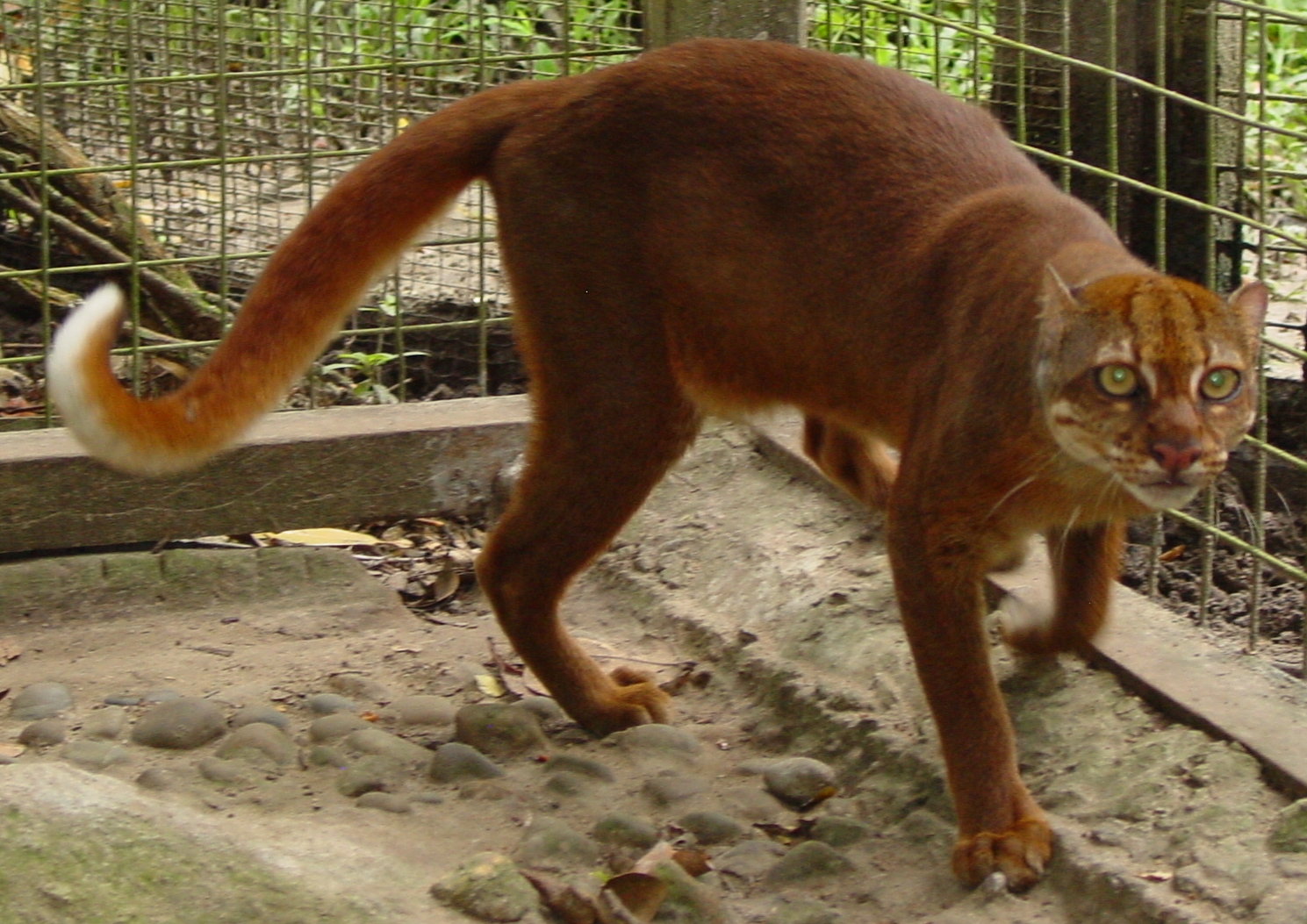
This beauty lives on the Indonesian island of Borneo, from which she borrowed her name. It is found in the jungle and in mountainous areas on the border with forests.
The dimensions are approaching the dimensions of an ordinary homemade pussy. Maximum length- up to 80 cm. The tail occupies a large part - up to 70%. The height at the withers is approximately 28cm. Weight from 2.3kg to 4.5kg. The ears of the Kalimantan are rounded and short. It has a special structure of teeth that is different from the cat's: the first molars on the upper jaw are smaller and single-rooted. And the rest of these teeth have two roots.
The color of representatives of this species comes in two colors: gray and the more common brown-reddish. In the belly area, the coat is lighter and has dark spots on it. The head is usually dark brownish grey.
The bottom of the chin is light, two light brown stripes start from the corners of the eyes and go down the cheeks. On the back of the head, the marking in the form of the letter "M" is visible. The ears are a rich black-brown color. The tail tapers towards the tip, the lower part is yellowish at the base, turns white towards the end. And the tip is with a black spot.
Excellent hunters, the Kalimantai feed on small mammals, birds, reptiles and insects. They will not refuse to fall. They can even attack monkeys.
Concod, or Chilean

A population exists in Chile and western Argentina. They prefer moderately moist coniferous or mixed forests, especially places near water bodies.
Dimensions concod 56-76cm, tail -17-23cm. The weight of the animal is about 2.2 kg. Its large feet and claws are adapted for climbing tree branches, where the concod mainly lives. The head is short, broad and convex.
The fur has a brownish-gray color. Blackish speckles are scattered all over the body, merging into stripes on the back and tail.
This coloring is a wonderful natural disguise that helps in hunting. Rarely, but there are completely black individuals.
The animal gets food mainly at night, but under favorable conditions they are active during the day. They feed on rodents, birds, insects, and reptiles.
Geoffroy
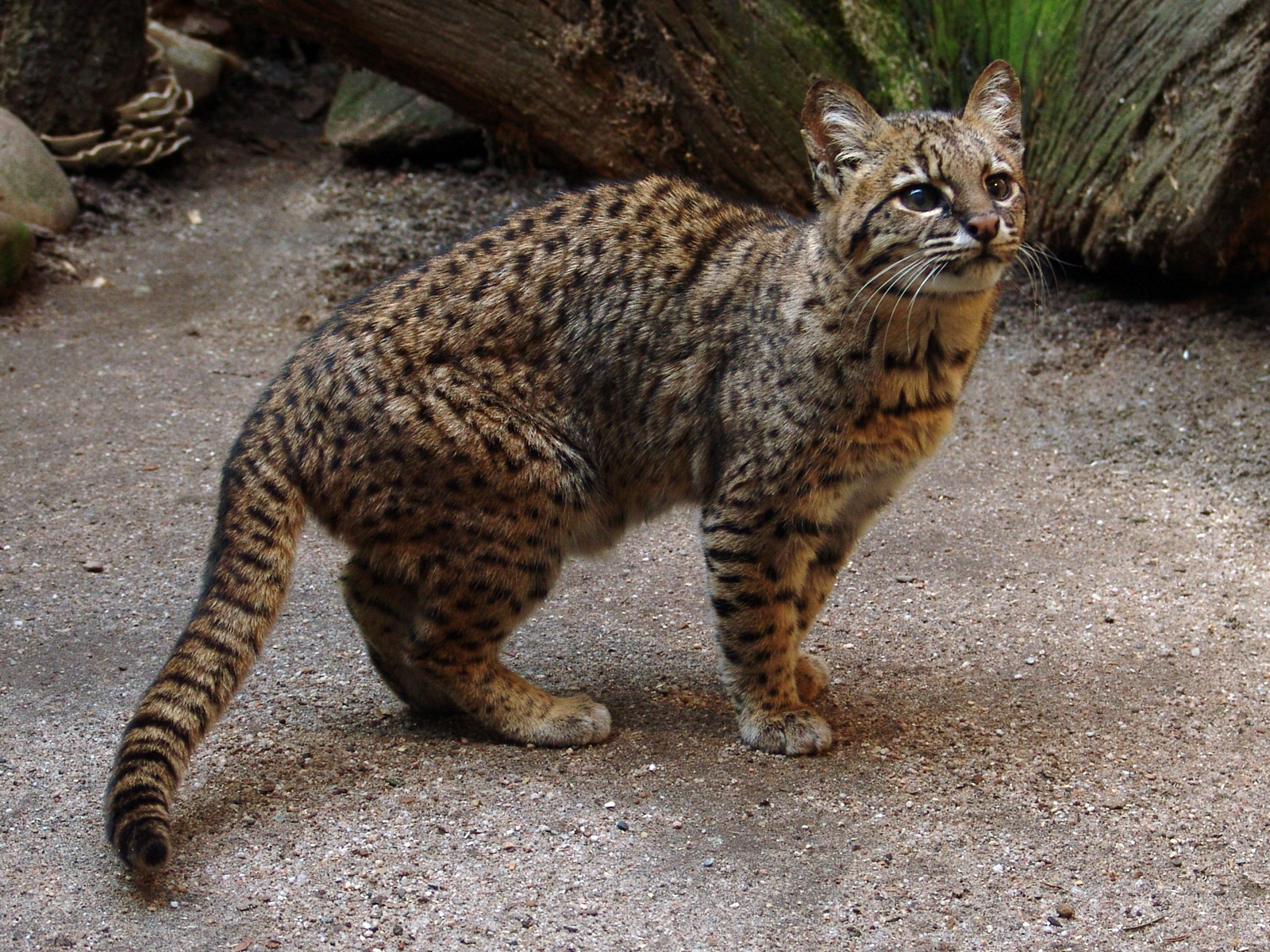
Named after the French professor of zoology Geoffrey Saint-Hilaire, who first described this species.
The area is the eastern part of South America. It lives in wooded upland areas, pampas and swamps, in alpine salt deserts. In priority - places with undersized dense vegetation.
Geoffreys are small - from 70 cm to 110 cm, of which 3/8 falls on the tail. Height at the shoulders - 23cm. Average weight cats 4.8 kg, females - 4.2 kg.
Geoffroy has large, low-set eyes and semi-circular ears.
The color of the majority is yellow-golden, with black spots-specks all over the body. On the muzzle from the corners of the eyes and mouth to the ears, as well as vertically along the forehead, there are black stripes.
Ears - rounded, blackish outside with a white spot in the center. The blackish tail is decorated with transverse spots or rings. There is also a transverse pattern on the abdomen.
These nocturnal dwellers prefer to forage on the ground and near water, or in trees. Small hares, rats, guinea pigs become prey. Excellent swimmers, they swim across fast rivers more than 30m wide without any problems, they catch fish. They try to hide food supplies on the branches of trees.
Caracal, he is a desert lynx

Range: Africa, including Sahara, Asia Minor and Central Asia. Prefers rain foothill forests. Although it is also found in dry areas. And on the Arabian Peninsula, it generally lives in the desert.
Reminiscent of a lynx, its dimensions are 65-82 cm (one third of the tail), on the shoulders -45 cm. Weighs 11-13kg. The coat is thick and short.
The coloration is yellow-sandy or brown-reddish above, whitish below. There are white spots around the eyes. On the chin - also light-colored fur. There are tassels up to 5 cm on the ears, they are black in color.
The caracal is active at night. True, in winter and spring it gets food during the day. They eat mongooses, hedgehogs, antelopes, lizards, plants. They attack small livestock.
Ocelot

Found in Central and South America. Chooses dense subtropical and tropical forests, shrubs.
Dimensions 135-150cm (tail 30-40cm). The ocelot is a beautiful, slender, powerful animal. Moves well through the trees, swims. He has a massive head.
Coloring - sandy yellow, golden brown with gray tint. Along it are longitudinal darkish stripes, stains and specks.
Powerful jaws, honed incisors allow you to grab and butcher prey. But they are not adapted to chewing.
The ocelot is active at night. Gets food on the ground, on trees. Rabbits, rodents, snakes, even monkeys become prey.
Serval
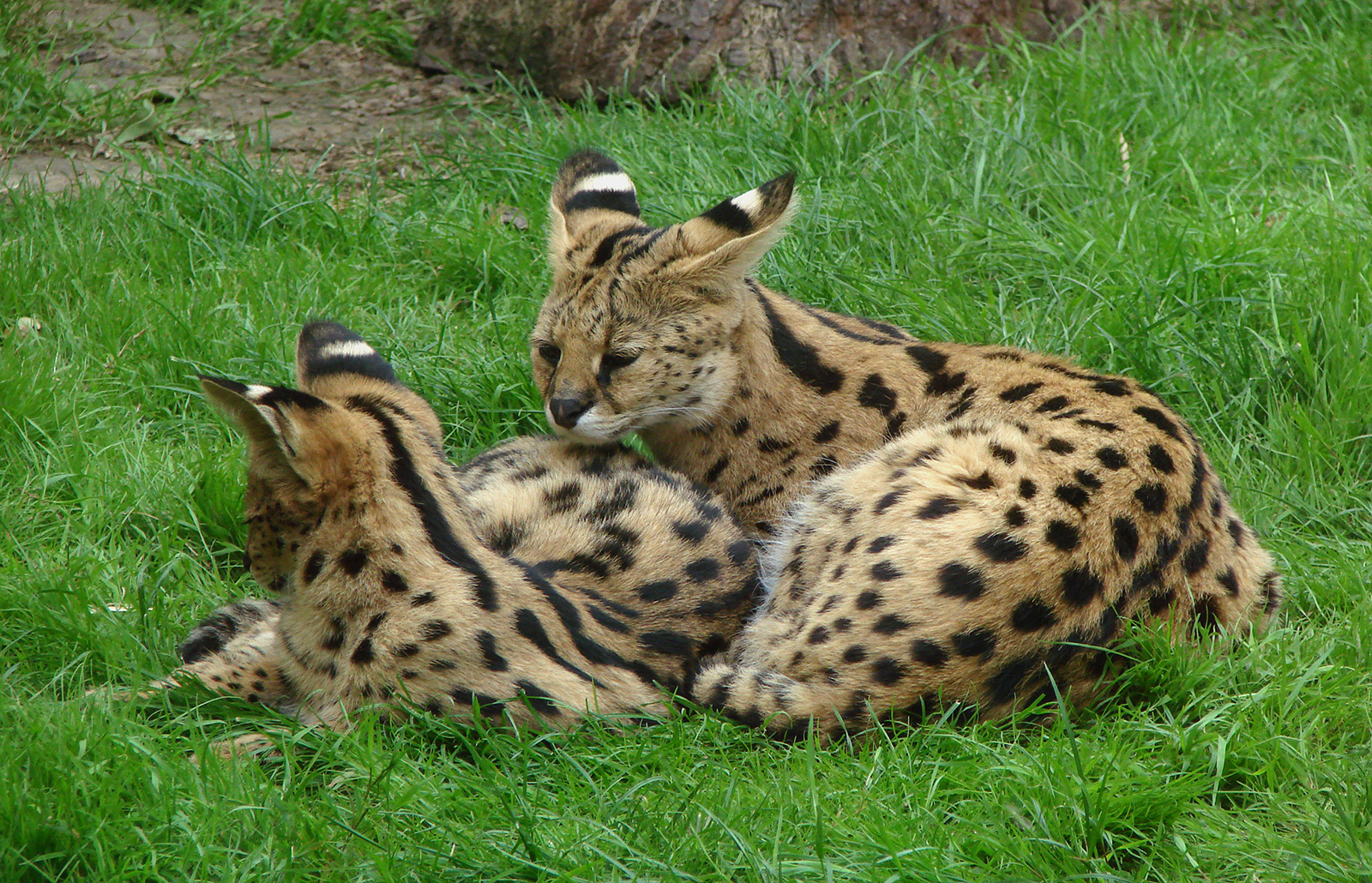
It lives in Africa, in tropical rainforests.
Reaches 90-135 cm (one third - on the tail), height 65 cm at the withers. Their weight is from 13kg to 16kg. Large, disproportionate ears provide the owner with heightened hearing. Outside, the ears are black with transverse yellow dots. The pupils are round.
Servals have long, well-developed legs. Excellent high-jumping (up to 3 m), these hunters are able to catch prey in the air.
There are spots on the fur. It forages mainly during the day and at dusk.
A feature of the serval is that it is able to adapt and live with a person. But problems still exist: servals are monogamous, attached to a single owner. They live for about 20 years. And this must be taken into account.
Jaguarundi, they are airs
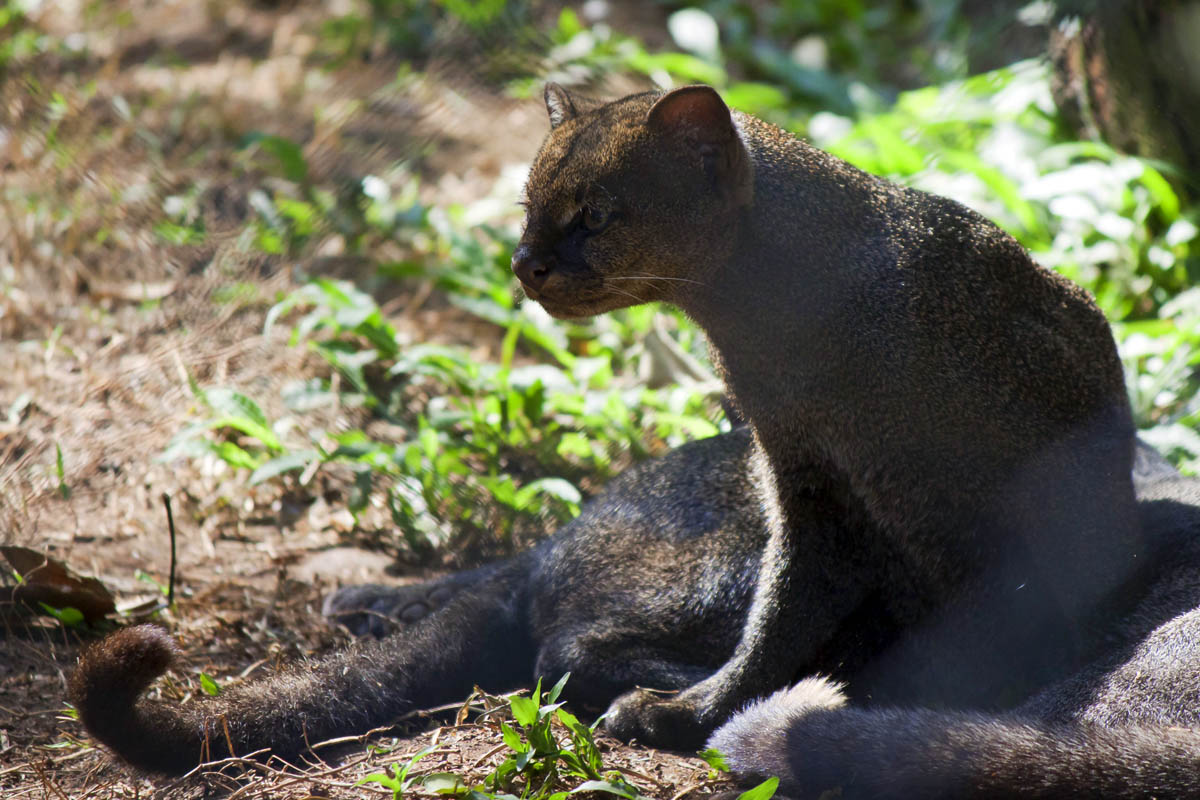
They live from the southern states of the USA to Northern Argentina, on the coast of Mexico, southern Brazil, a small number lives in southern Texas. They live in savannahs, in tropical rainforests. Often they choose places near water, on the banks of lakes, rivers, streams.
Animals are 55-70 cm long (a huge tail is half), 25-35 cm high, weigh from 4 kg to 8 kg. They have a round head, small semicircular ears, a short muzzle, an elongated body on strong short legs.
The coat is short, monophonic or finely speckled. The main color is grayish-brown or red, in adult animals there is almost no pattern.
The jaguarundi is a diurnal predator. Its prey are rodents, hares, insects. May attack poultry. With pleasure they eat fruits - grapes, bananas, figs.
How to tame a wild cat

In short, no way. Domestication of such animals is impossible in principle. We are not talking about circus training, there are completely different conditions for keeping animals. And to “domesticate” them, turning them into a cute kitty, is very problematic. And there are a number of reasons for this. Small ones, yes big cats for the most part, singles. They do not recognize either competitors or partners nearby. Couples are created only for the period of procreation, and relations with the rest of the representatives of the animal world are divided into two options: they are either a threat or prey. And the person does not fit into this scheme. He can be seen as a competitor and treated accordingly. And other pets are simply doomed.
And even an attempt to take a savage into the family - a kitten does not save from the natural aggressiveness of the beast. Growing up, a cute kitten will run wild and eventually begin to establish itself in a new team.
Very strong, much stronger than their domestic relatives, "savages" pose a serious danger to everyone around.
Food is also not easy. A "domesticated" predator will require a special diet that is 100% identical to the natural one. Violation of it is fraught with a failure in phosphorus-calcium metabolism, softening of the bones. The result may be their curvature, even a fracture. The treatment of such injuries is very difficult, because 80% of these cats do not tolerate anesthesia. In addition, a veterinarian specializing in the health of such animals is a rarity.
Another serious problem is that “savages” do not at all recognize trays, pots with filler. And they will spoil where they want, that is, everywhere. Given the strong, pungent smell of cat feces, imagine what your home could become.
In addition, there are a sufficient number of special breeds. They are bred by crossing different types feline. These are Savannah, Tiger, Asian, Chausie, Serengeti. Your pet will look like a savage, but at the same time have a wonderful character and manners.
A photo

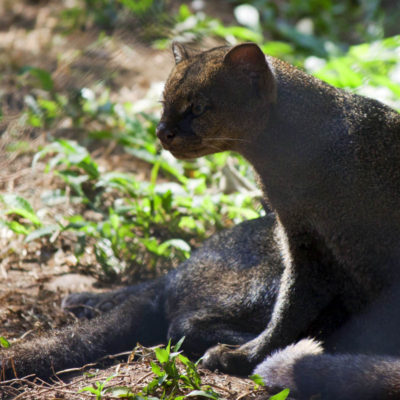
![]()
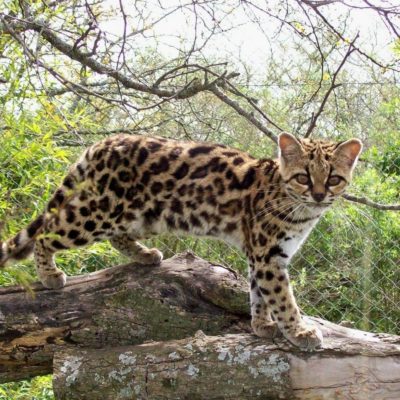








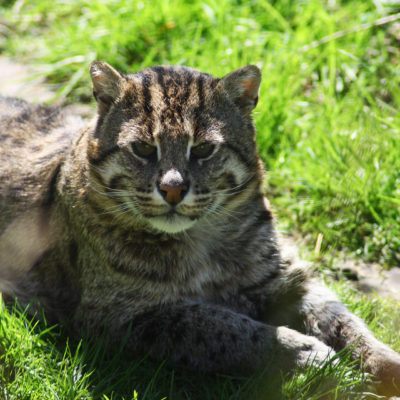



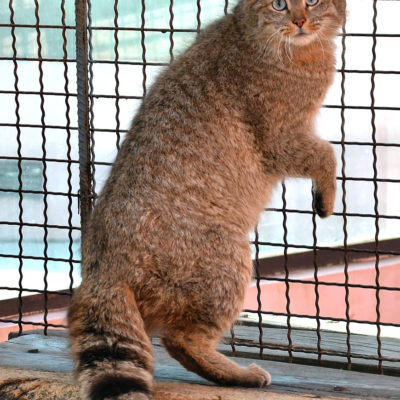

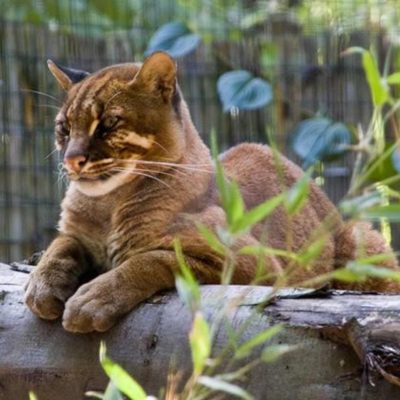


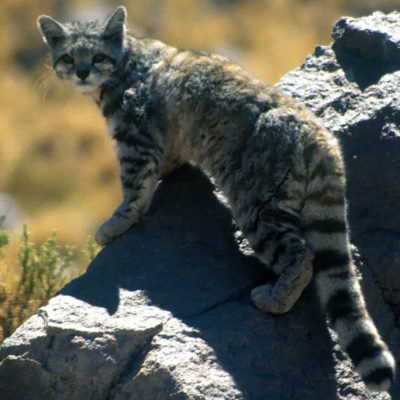
Video
The cat family is very cautious, mysterious, graceful and unusually attractive animals. Unfortunately, many of them are already listed in nature protection books or are even on the verge of extinction, and hunting is prohibited. We decided to make Top 20 most beautiful representatives of the cat family living all over the world and occupying a wide variety of habitats. You can also check out Rating of the most beautiful cat breeds.
In addition, on the site you can see a collection of photographs on the topic: Friendship between man and lion , Friendship between man and tiger.
20. Serval (bush cat)
Predatory mammal of the cat family. Servals are distributed almost throughout Africa, excluding the Sahara, foreststhe equatorial zone and the extreme south of the mainland (Cape Province). North of the Sahara (Algeria, Morocco) this beast is now extremelyrare, but still quite common in East and West Africa. There are about 14 subspecies. HThey inhabit open spaces with shrubs and grassy thickets, settling, as a rule, near water. They areavoid deserts, dry plains and tropical rainforests, keeping to the edges of the latter.It is an object of fishing, as its skin is used for fur products; it is also valued in parts of Africa due toyour meat. It is also exterminated due to attacks on poultry.As a result, in the densely populated areas of Africa, the number of servals has dropped markedly. Quite easily tamed andcan be kept in captivity as pets. Serval males can mate with ordinary domestic cats, giving hybrids -"savannah".
19. Jaguarundi

A species of predatory mammals, which also includes the genus Puma. Outwardly, the jaguarundi somewhat resembles a member of the familymustelids or viverrids: she has an unusually elongated, flexiblea body on short strong legs and a long thin tail, which in general makes it look like a weasel or Madagascar fossa.Demonstrates great flexibility in the choice of habitats. These cats were found in the savannas, in the thorny thickets of chaparral, duringhumid tropical forests. Features of the structure of the body allow him to easily make his way among the thick grass and shrubs.Jaguarundis often settle near water - in wetlands, along the banks of streams, rivers and lakes. In the mountains they climb to a height of up to3200 m above sea level. Secretive animals leading a predominantly solitary lifestyle (with the exception of the mating season).Unlike most cats, jaguarundis are active mainly during the day; the peak of their activity falls on 11hours of the morning. Jaguarundis are terrestrial animals, however they can climb and swim well. Due to its wide range, this animal is notbelongs to the protected species, although in the southern United States it has become rare. Little is known about its abundance and ecology.

Wild cat of Southeast Asia: in the eastern Himalayas, Sumatra and Borneo. Marble cats are slightly larger than domestic cats. Their length is about 55 cm, not including the 50 cm tail. The coat pattern is reminiscent of a clouded leopard. Their immediate habitat is tropical forests. Being a nocturnal hunter, the marbled cat feeds on rodents, especially squirrels, toads, birds and insects. Unlike the Bengal cat living on the ground, it moves mainly in the branches of trees, and thus both species do not compete with each other. Hunting for it is prohibited in Bangladesh, China (only in Yunnan), India, Malaysia, Indonesia, Myanmar, Nepal and Thailand.

Wild small cat from the genus of Asian cats. A close relative of the Bengal cat. The smallest member of the cat family. Lives only in India and Sri Lanka. The species is threatened with extinction as the species has fewer than 10,000 adults.representatives with a constant decline, due to changes in the natural habitat.Ceylon rusty cats live in the rainforest, while the Indian population inhabits dry open areas.Rusty cats are nocturnal and live alone. Their behavior is very close to that of a Bengal cat. To theirprey include mice, lizards and insects. Despite being good at climbing trees, rusty cats most of the timeusually carried out on the ground.
16. Cheetah

A predatory mammal of the cat family, the fastest land animal. Noticeably different from other members of the cat family. The body is slenderwith well-developed muscles and practically no body fat, it even seems fragile. The claws are partially retractable, which is not typical for cats and except forthe cheetah is observed only in the fishing cat, Sumatran and Iriomote cats. Cheetahs are diurnal predators. They are huntingmainly on medium-sized ungulates: gazelles, impalas, wildebeest calves, as well as on hares. Three cheetahs can defeat an ostrich.87% of the cheetah's prey is Thomson's gazelle. Cheetahs usually hunt early in the morning.or in the evening, when it is no longer very hot, but still light enough. They navigate more by sight than by smell. Unlike other cats,cheetahs hunt by stalking prey, not by ambush. In pursuit of the victim, it develops speed up to 110-115 km / h, accelerates to 75 km / h in2 seconds. In Africa, the cheetah is the weakest of the large predators. Hyenas, leopards and lions can take prey from cheetahs,taking advantage of the fact that the cheetah needs up to half an hour to rest after the chase. The cheetah only eats the animals it has killed.himself, sometimes drags prey into the bushes,to hide it from predators and eat it later, but more often it hunts again each time.

Margay is sometimes kept in South America as a domestic cat. Forest margays differ from ordinary pets in strong long legs, in addition, they are somewhat larger. The length of a cat without a tail is about 60 centimeters. They are also called a smaller copy of the ocelot. But the margay's tail is special - two-thirds of the length of the entire cat, it is decorated with stripes and rings. Margay is also called the long-tailed cat. He balances with his tail, moving in crowns along thin branches. It lives in trees and finds its prey there. Just like an ordinary cat, margay hunts lizards or small birds. The only one of all felines, the margay can twist its ankles 180 degrees and climb a tree just like a squirrel - up or down. Due to deforestation and the diligence of hunters, margays are becoming rarer, and are already recognized as an endangered animal. Alas, in zoos they breed very poorly.

A wild cat from the genus Catopum that lives in the tropical forests of Southeast Asia. Previously, it was attributed to the now abolished genus of golden cats. Today it is believed that its resemblance to the golden cat found in Africa is based on convergent evolution. The species is named after the Dutch zoologist Konrad Temminck. More than twice the size of a normal domestic cat. Its length is 90 cm, not counting the tail, which is 50 cm long. The range of the Temminka cat stretches from the Himalayas and southern China to the Indochinese Peninsula, and it is also found in Sumatra. Inhabits forest biotopes. Due to deforestation and hunting, the Temminka cat has become a rare animal. In China, its meat is considered a delicacy, and its bones are used in traditional Chinese medicine. In Thailand, there are a lot of legends around her, according to one of which it is believed that burning the hair of the Temminka cat drives away tigers from the surroundings, and carrying at least one hair from her wool, according to local signs, protects against tiger attacks.

Predatory mammal from the cat family, common in Central America, northern and centralparts of South America. The northernmost region where ocelots live is in the US state of Texas. Its population is concentrated intropical forests, ocelot avoids open spaces. Ocelots live alone and hunt primarily at night. Duringduring the heat of the day, they like to hide in the hollows of trees. Despite their excellent ability to climb trees and stones, they huntearth. Ocelot prey includes mainly small mammals and birds, howeversometimes they do not disdain snakes. The largest specimens of the ocelot also overpower small donkeys and pigs.Due to the intense hunting for it, the ocelot has become an extremely rare animal in our time. Thanks to new interstateunder the agreements, the hunting of ocelots, as well as the sale of any products made from ocelots, is prohibited.

A member of the cat family that lives in Southeast Asia. It vaguely resembles a leopard and is considereda fairly ancient species, as well as a possible ancestor of the current large felines. Its value corresponds to approximatelyshepherd size. Clouded leopard is found in southeast Asia: from southern China to Malacca and from the eastern Himalayas toVietnam. The subspecies found in Taiwan is extinct. His biotopeare tropical and subtropical forests located at altitudes up to 2000 meters. Live alone and move around normallyin the thickets. The long tail helps them keep their balance in difficult environments. Among the feline smokyLeopards are the best at climbing trees. They also swim well. Their prey includesdeer, wild boars, monkeys, birds, goats, reptiles. They wait for their victims on the branches and suddenly jump on them from above.Because of the precious skin, the clouded leopard was hunted a lot in the past. Today it is threatened by poaching, butgreatest danger to its conservationrepresents the progressive deforestation of the tropical forests that are its home.

Type of cat family. The dune cat is the smallest among wild cats: its body length is 65-90 cm,with 40% occupied by the tail. The feet are covered with hard wool, which protects the soles of the paws from burns with hot sand.The fur is thick and soft, protecting the body from low night temperatures. The range of the dune cat looks like a strip startingin the Sahara (Algeria, Morocco, Chad, Niger) and through the Arabianpeninsula to Central Asia (Turkmenistan, Uzbekistan, Kazakhstan) and Pakistan. Lives exclusively in hot, dryareas. Its habitats are very diverse, from sandy deserts. Dune cats are strictly nocturnal.Only the Pakistani subspecies is active mainly at dusk in winter and early spring. From the heat of the day they are saved inshelters - in the old holes of foxes, corsacs, porcupines, as well as in the expanded minks of ground squirrels and gerbils.Cats are carnivorous; their diet includes almost all the game that they can find. Its basis is made up of gerbils,jerboas and other small rodents, lizards, spiders and insects. Sometimes tolai hares and birds whose nests are ruined.The dune cat is also known for its hunting of poisonous snakes (horned viper, etc.). In winter, she sometimes approaches the villages,but does not attack domestic cats and birds. Most of the moisture dune cats get from food and can for a long timego without water. The natural enemies of dune cats are snakes, large birds of prey and jackals.Sometimes they dig shallow holes or pits on their own, where they hide in case of danger. Ppractically devoid of vegetation, to rocky valleys overgrown with shrubs. They are not huntedhowever, they are caught for sale. They also suffer from the destruction of their natural habitat.In general, the dune cat is the most “prosperous” species among wild cats.

Predatory mammal of the cat family. His second name - Pallas cat - he received in honor of the German naturalistPeter Pallas, who discovered manul on the coast of the Caspian Sea in the 18th century. Manul is an animal the size of a domestic cat.The fur of the manul is the most fluffy and thick among the cats. Distributed in Central and Central Asia, from South Transcaucasia andwestern Iran to Transbaikalia, Mongolia and Northwestern China. Manul habitats are characterized by sharply continentalclimate with low temperatures in winter and low snow cover; it is most numerous in areas with little snow. Inhabitsmanul steppe and semi-desert areas. leads a sedentary lifestyle. Active mainly at dusk and early morning; sleeps during the dayin shelter. The slowest and most clumsy of wild cats. Manul feeds almost exclusively on pikas and mouse-likerodents, occasionally catches ground squirrels, tolai hares, marmots and birds. Manul is not adapted to fast running. At risk forit is characterized by hiding; he also escapes enemies by climbingon stones and rocks. An alarmed manul makes a hoarse rumbling or a sharp snort.Manul is rare or extremely rare, and its numbers continue to decline. In some places it is on the verge of extinction,listed in the Red Book of the Russian Federation, in the IUCN Red List with the status of "close to threatened". manul huntinguniversally prohibited.

A species of mammals from the genus lynxes, the northernmost of the cat species; in Scandinavia, it is found even beyond the Arctic Circle.It was once very common throughout Europe, but by the middle of the 20th century it had been exterminated in most countries of Central Asia.and Western Europe. Successful attempts have now been made to revive the lynx population.forests, taiga, although it occurs in a variety of plantations, including mountain forests; sometimes enters the forest-steppe and forest-tundra.She climbs trees and rocks perfectly, swims well.She also survives well in the snow (beyond the Arctic Circle), catching fur-bearing animals. With an abundance of food, the lynx lives settled, withlack - roams. It can travel up to 30 kilometers per day. Hares form the basis of its diet. She alsoconstantly hunts grouse birds, small rodents, less often - small ungulates, such as roe deer, musk deer, spotted andreindeer, occasionally attacks domestic cats and dogs, in addition - foxes, raccoon dogs and other medium-sized animals.According to Russian zoologist Mikhail Krechmar, not a single confirmed case of a lynx attack on a person is known.Moreover, the lynx is known as one of the most easily tamed animals.

Predatory mammal of the cat family. For a long time, the caracal was attributed to lynxes, to which it looks similar, but a number ofgenetic features allocated it to a separate genus. Despite this, the caracal stands closer to lynxes than other cats.Although outwardly the caracal looks like a lynx, morphologically it is closest to the puma. The caracal is also close to the Africanserval, with which it crosses well in captivity. Found in the savannas, deserts and foothills of Africa, in the deserts of the Arabianpeninsulas, Asia Minor and Central Asia. Not numerous in the CIS: found in the deserts of southern Turkmenistan, along the coastThe Caspian Sea reaches the Mangyshlak Peninsula, in the east it sometimes appears in the Bukhara region of Uzbekistan.The caracal is active mainly at night, but in winter and spring it also appears during the day. Sheltered in rock crevices andburrows of porcupines and foxes; sometimes they are used for several years in a row. Its main food is rodents (gerbils,jerboas, ground squirrels), tolai hares, partly small antelopes, in Turkmenistan - gazelles. Sometimes it gets hedgehogs, porcupines,reptiles, insects, small predatory animals like foxes andmongoose, young ostriches. It can steal poultry, attack lambs and goats. Caracals are easily tamed. In Asia(India, Persia) with hand caracals hunted hares, pheasants, peacocks and small antelopes. In Africa, especially Southcaracal is quite common and is considered a pest. There is a special culture of caracal hunting: it is lured by instruments,imitating the cry of a wounded hare or mouse, and at night they shoot from under the headlights. In addition, in South Africa, caracals are used,to drive away birds (mainly guinea fowl) from the runways of military airfields.Asian subspecies of caracal are much rarer.
7. Leo

A species of carnivorous mammals, one of four representatives of the panther genus, belonging to the subfamily of big catswithin the cat family. It is the second largest living cat after the tiger -the weight of some males can reach 250 kg. The historical range of the lion was much wider than the modern one - even in the earlyin the Middle Ages, the lion was found throughout Africa, except for deserts and rainforests, and it could also be seenin the Middle East, Iran, and even in a number of places in southern Europe (for example, he lived in part of the territory of the modern south of Russia,rising to about the 45th parallel north). In North and Northwest India, the lion was a common predator. Howeverhuman persecution and habitat destruction have led to the fact that in Africa the lion survived only south ofSahara, its range is currently broken. In Asia, a small population exists in the Gir forest (in the Indian stateGujarat). Lions are considered vulnerable species due to the irreversible decline in their population. For the last twodecades, the number of lions in Africa has decreased by 30-50%. Populations are vulnerable outside protected areas.The reason for the decline is not fully understood, but the biggest threats are habitat loss and conflict. with a person.
6. Black Panther
![]()
The name of dark-colored individuals of a number of species of large cats, which are a genetic color variant - a manifestationmelanism caused by a gene mutation and is characteristic almost exclusively of females. An example of a strong spread of mutation,which leads to melanism, in the feline population, is the populationleopard in Malaysia, where about 50% of the animals are black in color.The black panther is not a separate species. Most often it is a leopard or a jaguar. The existence of melanistic cougarsnot confirmed. The word "panther" is often applied not only to individuals with a black color, but also to others with a normal color.(reddish or spotted), even white - the so-called "white panthers".
5. Jaguar

Big cats. The only representative of the genus in North and South America. The third largest in the world, and the mostlargest representative of the cat family in the New World. The range of the species extends from Mexico south to Paraguay and northArgentina. The main habitats of the jaguar are tropical rainforests and grasslands. The lifestyle of jaguars is solitary.The jaguar is a crepuscular predator. His most active hunting hours are after sunset and beforedawn. Its main prey is capybaras and ungulates like mazama deer, peccaries and tapirs, but it also attacks birds,monkeys, foxes, snakes, rodents. The jaguar also hunts turtles - its powerful jaws are able to bite through their shell. Unlikefrom the cougar, the jaguar willingly and often attacks livestock. The predator is an excellent swimmer and rarely misses the prey that is looking forrescue in the water. He also digs out of the sand on the ocean coastturtle eggs, sometimes throwing themselves at sleeping alligators or snatching fish from the water. Over much of its former rangethis species is almost or completely exterminated. The change by people of the natural habitats of jaguars, fishingfor the sake of a valuable skin, as well as shooting by cattle breeders who feared for the safety of their herds.The jaguar is listed in the international Red Book and is protected in many countries. Shooting jaguars in limited quantitiesallowed in Brazil, Mexico and some other countries. Hunting for trophies is allowed in Bolivia.
4. Leopard

In the XX century, it was included in the IUCN Red Book, in the Red Book of Russia, as well as in the security documents of other countries. However, in many African countries, the relatively high number of leopards makes it possible to allocate an annual quota for their prey. The big cat, however, is much smaller than the tiger and lion. The range of the leopard is wider than the range of any other member of the cat family, with the exception of the domestic cat. The plasticity of the species is explained by the secretive way of life and its ability to hunt a wide variety of animals. By the middle of the 20th century, the range of the leopard in the Caucasus was catastrophically reduced, its numbers are negligible, and in fact this subspecies is on the verge of complete extinction. Inhabits forest, partially forest-steppe regions, savannahs and mountainous regions of Africa and the southern Front and southern half of East Asia. The leopard feeds mainly on ungulates: antelopes, deer, roe deer and others, and during the period of starvation - rodents, monkeys, birds, reptiles. Sometimes attacks domestic animals (sheep, horses). Like a tiger often kidnaps dogs; foxes and wolves suffer from it. It does not disdain carrion and steals prey from other predators, including other leopards. The number of leopards throughout the range is steadily declining. The main threat to it is associated with changes in natural habitats and a reduction in food supply. The main concern is the poaching of animals for the needs of oriental medicine.
3. Puma (mountain lion, cougar)

Type of cat family. The word puma comes from the Quechua language. The closest relatives of the cougar are the jaguarundi and the extinct North American genus Miracinonyx. The cougar is the second largest feline in America; only the jaguar is bigger than her. Historically, the range of the cougar was the most extensive among all land mammals in America. Even now, in terms of the breadth of distribution, the cougar is comparable (of the cats) only with the red lynx, forest cat and leopard. Initially, cougars were found almost everywhere from southern Patagonia to southeast Alaska; the area of its distribution quite accurately coincided with the range of its main prey - various deer. Now in the United States and Canada, the cougar has survived mainly in the mountainous western regions. In the east of North America, the cougar was completely exterminated; the exception is a tiny population of the Puma concolor coryi subspecies in Florida. Cougars lead a strictly solitary lifestyle. Puma hunts mainly at night. Its diet consists mainly of ungulates: black-tailed, white-tailed, pampas deer, wapiti (American red deer), elk, caribou, bighorns and livestock. However, the cougar can eat a wide variety of animals - from mice, squirrels, opossums, rabbits, muskrats, porcupines, Canadian beavers, raccoons, skunks, armadillos to coyotes, bobcats and other cougars. They also eat birds, fish, and even snails and insects. Unlike tigers and leopards, the cougar does not distinguish between wild and domestic animals, attacking livestock, dogs, cats and birds when the opportunity arises. In doing so, she slaughters more animals than she can eat. Despite the fact that cougars serve as an object of hunting and their range is declining due to environmental destruction, most subspecies are quite numerous, since cougars easily adapt to life in different landscapes. It is also interesting to note that now some people have begun to tame cougars as their pets.
2. Snow leopard (irbis or snow leopard)

A large predatory mammal from the cat family that lives in the mountain ranges of Central Asia.Weighs up to 55 kg. Due to the inaccessibility of the habitat and the low density of the species, manyaspects of its biology. At present, the number of snow leopards is catastrophically small; in the 20th century, it was included in the Red BookIUCN, in the Red Book of Russia, as well as in the security documents of other countries. As of 2012, snow leopard hunting is prohibited.The range of the snow leopard in central and southern Asia covers the territory of mountainous regions with an area of approximately 1,230,000 km² andextends through the territory of the following countries: Afghanistan, Myanmar, Bhutan, China, India,Kazakhstan, Kyrgyzstan, Mongolia, Nepal, Pakistan, Russia, Tajikistan and Uzbekistan.The irbis is a characteristic representative of the fauna of the high rocky mountains of Central and Central Asia. Among the large catsthe irbis is the only permanent inhabitant of the highlands. It mainly inhabits alpine meadows, treelesscliffs, rocky areas, rocky outcrops, precipitous gorges and is often found in the snow zone. Active at dusk, but sometimes during the day.The snow leopard is able to cope with prey three times its mass.The main prey of the snow leopard almost everywhere and all year round is ungulates. It should be noted that due to the constanthuman persecution, the number of snow leopards is continuously declining.
1. Tiger


A species of carnivorous mammals of the cat family, one of the four representatives of the panther genus, which belongs to the subfamilybig cats. Among the representatives of this species are the largest animals of the cat family. The tiger is one ofthe largest land predators, yielding in mass only to the white and brown bears. Nine subspecies of the tiger have been identified.In the 20th century, it was included in the IUCN Red Book, in the Red Book of Russia, as well as in the security documents of other countries.As of 2012, tiger hunting is banned worldwide. The tiger is an exclusively Asian species. Historical range of the tiger(now strongly dissected into separate populations, sometimes very distant from one another) is located on the territory of the FarEastern Russia, Iran, Afghanistan, China, India and the countries of Southeast Asia, including the Sunda Archipelago(Indonesian islands). In the wild, tigers mainly feed on ungulates, sometimes they can hunt domestic animals,such as dogs, cows, horses and donkeys. Throughout its range, the tiger is at the top of the food pyramid and almostdoes not experience competition from other predators.
- Burns, Robert - short biography
- The concept of common vocabulary and vocabulary of limited use
- Nancy Drew: The Captive Curse Walkthrough Nancy Drew Curse of Blackmoore Manor Walkthrough
- Deadpool - Troubleshooting
- Won't start How to Survive?
- What to do if bioshock infinite won't start
- Walkthrough Nancy Drew: Alibi in Ashes
- Spec Ops: The Line - game review, review Spec ops the line crashes on missions
- Room escape level 1 walkthrough
- Processing tomatoes with boric acid How much will 2 grams of boric acid
- Cucumber Grass (Borago)
- Bioinsecticide Lepidocid: purpose, properties and application procedure Lepidocide waiting period
- How to change the language to Russian in steam
- Dendrobium noble: room care
- Morphology of plants general concepts - document
- Planting, propagation and care of bamboo at home, photo Growing bamboo from seeds
- How to strengthen the cellular signal for the Internet in the country
- Sanskrit reveals the forgotten meaning of Russian words (2 photos)
- The oldest language Sanskrit programming language of the future Dead language Sanskrit
- Who has dominion over all the earth?









